CyberTAN Technology WM821MHP WIRELESS 802.11N DUAL BAND MINI PCI MODULE User Manual 54M WLAN
CyberTAN Technology Inc. WIRELESS 802.11N DUAL BAND MINI PCI MODULE 54M WLAN
USERS MANUAL

WM821-M MiniPCI Module
WM821-M
Wireless 802.11N dual-band mini PCI module
User Manual
Rev 1.0

WM821-M MiniPCI Module
Federal Communication Commission Interference Statement
This equipment has been tested and found to comply with the limits for a Class B digital device, pursuant
to Part 15 of the FCC Rules. These limits are designed to provide reasonable protection against harmful
interference in a residential installation. This equipment generates, uses and can radiate radio frequency
energy and, if not installed and used in accordance with the instructions, may cause harmful interference
to radio communications. However, there is no guarantee that interference will not occur in a particular
installation. If this equipment does cause harmful interference to radio or television reception, which can
be determined by turning the equipment off and on, the user is encouraged to try to correct the interfer-
ence by one of the following measures:
- Reorient or relocate the receiving antenna.
- Increase the separation between the equipment and receiver.
- Connect the equipment into an outlet on a circuit different from that
to which the receiver is connected.
- Consult the dealer or an experienced radio/TV technician for help.
FCC Caution: Any changes or modifications not expressly approved by the party responsible for compli-
ance could void the user's authority to operate this equipment.
This device complies with Part 15 of the FCC Rules. Operation is subject to the following two conditions:
(1) This device may not cause harmful interference, and (2) this device must accept any interference re-
ceived, including interference that may cause undesired operation.
IMPORTANT NOTE:
FCC Radiation Exposure Statement:
This equipment complies with FCC radiation exposure limits set forth for an uncontrolled environment.
This equipment should be installed and operated with minimum distance 20cm between the radiator &
your body.
This transmitter must not be co-located or operating in conjunction with any other antenna or transmitter.
Operations in the 5.15-5.25GHz band are restricted to indoor usage only
IEEE 802.11b or 802.11g operation of this product in the U.S.A. is firmware-limited to channels 1 through
11.
When using the device in the in United States (or where FCC rules apply), it is the responsibility of the profes-
sional installer to ensure to control the output power not grater then the application.

WM821-M MiniPCI Module —Introduction
IMPORTANT NOTE:
This module is intended for OEM integrator only and limited to host with brand: HP and model: Medi-
aSmart Connect x280n. The OEM integrator is still responsible for the FCC compliance requirement
of the end product, which integrates this module.
USERS MANUAL OF THE END PRODUCT:
In the users manual of the end product, the end user has to be informed to keep at least 20cm sepa-
ration with the antenna while this end product is installed and operated. The end user has to be
informed that the FCC radio-frequency exposure guidelines for an uncontrolled environment can be
satisfied. The end user has to also be informed that any changes or modifications not expressly ap-
proved by the manufacturer could void the user's authority to operate this equipment.
The FCC part 15.19 statement below has to also be available in the manual:
This device complies with Part 15 of FCC rules. Operation is subject to the following two conditions:
(1) this device may not cause harmful interference and (2) this device must accept any interference
received, including interference that may cause undesired operation.
LABEL OF THE END PRODUCT:
The final end product must be labeled in a visible area with the following " Contains TX FCC ID: N89-
WM821MHP ".
Manual Information To the End User
The OEM integrator has to be aware not to provide information to the end user regard-
ing how to install or remove this RF module in the user’s manual of the end product
which integrates this module.
The end user manual shall include all required regulatory information/warning as show in this manual.
ii

Preface
Canadian Regulatory Notice
This device complies with RSS-210 of the Industry Canada Rules. Operation is subject to the follow-
ing two conditions:
1) this device may not cause interference and
2) this device must accept any interference, including interference that may cause undesired opera-
tion of the device
Cet appareil numérique de la classe B or A conforme á la norme NMB-003 du Canada.
Operation is subject to the following two conditions: (1) this device may not cause interference and (2)
this device must accept any interference, including interference that may cause undesired operation
of the device.
For product available in the USA/Canada market, only channel 1~11 can be operated. Selection of
other channels is not possible.
This device and its antenna(s) must not be co-located or operation in conjunction with any other an-
tenna or transmitter.
To reduce potential radio interference to other users, the antenna type and its gain should be so cho-
sen that the equivalent isotropically radiated power (e.i.r.p) is not more than that permitted for
successful communication.
Caution:
The device for the band 5150-5250 MHz is only for indoor usage to reduce potential for harmful inter-
ference to co-channel mobile satellite systems.
IMPORTANT NOTE:
IC Radiation Exposure Statement:
This equipment complies with IC radiation exposure limits set forth for an uncontrolled environment.
This equipment should be installed and operated with minimum distance 20cm between the radiator
and your body.
The device could automatically discontinue transmission in case of absence of information to transmit,
or operational failure. Note that this is not intended to prohibit transmission of control or signaling in-
formation or the use of repetitive codes where required by the technology.
The device for the band 5150-5250 MHz is only for indoor usage to reduce potential for harmful inter-
ference to co-channel mobile satellite systems.
The maximum antenna gain permitted (for devices in the bands 5250-5350 MHz and 5470-5725 MHz)
to comply with the e.i.r.p. limit.
The maximum antenna gain permitted (for devices in the band 5725-5825 MHz) to comply with the
e.i.r.p. limits specified for point-to-point and non point-to-point operation as appropriate, as stated in
section A9.2(3).
iii

WM821-M MiniPCI Module —Introduction
High-power radars are allocated as primary users (meaning they have priority) of the bands 5250-
5350 MHz and 5650-5850 MHz and these radars could cause interference and/or damage to LE-LAN
devices.
IMPORTANT NOTE:
This module is intended for OEM integrator only and limited to host with brand: HP and model: MediaS-
mart Connect x280n
. The OEM integrator is still responsible for the IC compliance requirement of the end product, which
integrates this module.
20cm minimum distance has to be able to be maintained between the antenna and the users for the
host this module is integrated into. Under such configuration, the IC RSS-102 radiation exposure lim-
its set forth for a population/uncontrolled environment can be satisfied.
Any changes or modifications not expressly approved by the manufacturer could void the user's au-
thority to operate this equipment.
USERS MANUAL OF THE END PRODUCT:
In the users manual of the end product, the end user has to be informed to keep at least 20cm sepa-
ration with the antenna while this end product is installed and operated. The end user has to be
informed that the IC radio-frequency exposure guidelines for an uncontrolled environment can be sat-
isfied. The end user has to also be informed that any changes or modifications not expressly
approved by the manufacturer could void the user's authority to operate this equipment. IC statement
is required to be available in the users manual: This Class B digital apparatus complies with Cana-
dian ICES-003. Operation is subject to the following two conditions: (1) this device may not cause
harmful interference and (2) this device must accept any interference received, including interference
that may cause undesired operation.
LABEL OF THE END PRODUCT:
The final end product must be labeled in a visible area with the following " Contains TX IC: 5005A-
WM821MHP".
iv

WM821-M MiniPCI Module
Chapter 1
Introduction
The WM821-M is a dual-band, quad-mode wireless network adapter that works on all the frequencies
allocated for WLAN operation everywhere in the world. It is in compliance with the Draft IEEE802.11n
standard in a 2x3 MIMO configuration. It also complies with the IEEE 802.11a, 802.11g, and 802.11b
standards. WM821-M features the compactness and high bus speed of the Mini PCI specifications
which gives users of laptops, notebooks, tablet PCs, and other mobile computing devices transparent
Internet access anywhere in the world through any Wi Fi network without software changes or additional
hardware.
Able to provide greater than 100Mbps real world throughput using high-speed spatial multiplexing
modes, the WM821-M provides the freedom to work as you wish, wherever you wish, using whatever
kind of application you wish to use. The adapter installs directly in any host device with a Mini PCI slot:
just plug it in and you’re ready to access local resources and/or the Internet at the highest speed the
WLAN, the location, and the host computer can provide. It is ready to work “out of the box” in any em-
bedded device or in any computer running Microsoft® Windows 2000, or XP. The WM821-M Mini PCI
Card is truly a “must-have” for every productivity-sensitive laptop, notebook, or tablet PC user and any
bandwidth-sensitive embedded design..
.
Features
• mPCI 32 interface.
• Draft IEEE 802.11n compatible.
• Backward compatible with IEEE 802.11a/b/g standard.
• Wire-free access to networked resources from anywhere beyond the desktop.
• Delivers data rates up to 300 Mbps.
• 802.11n: Dynamically shifts among 130, 117, 104, 78, 52, 39, 26 and 13Mbps in a 20MHz band-
width and 300, 243, 216, 162, 108, 81, 54 and 27Mbps in a 40MHz bandwidth, based on signal
strength, for maximum availability and reliability of connection.
• 802.11a/g: Dynamically shifts between 54, 48, 36, 24, 18, 12, 9 and 6 Mbps network speed, based
on signal strength, for maximum availability and reliability of connection.
• 802.11b: Dynamically shifts between 11M, 5.5M, 2M, and 1 Mbps network speed, based on signal
strength, for maximum availability and reliability of connection.
• Supports 802.11h (DFS) power adjustment (11a mode only).
• Allows users move between Access Points without resetting the connection reconfigurations.
• Three ultra-mini connectors with for diversity antennae.
• Uses 2.4GHz and 5GHz frequency band, complying with regulatories worldwide
• Supports most popular operating systems: Window 2000/XP. Linux support is also available.
• Ensures great security by providing the 64/128 bits Wired Equivalent Privacy (WEP) and WiFi Pro-
tected Access (WPA) defined in the IEEE standard.
• WPA support. Radius clients in EAP-TLS, EAP, TTLS, EAP-LEAP, EAP, PEAP.
• WPA2, WMM-compliant.
• WiFi-Protected Setup(WPS)-supported
WiFi-Protected Setup(WPS)-supportedWhat is Wireless LAN?
Wireless Local Area Network (WLAN) systems offer a great number of advantages over traditional wired
systems. WLANs are flexible and easy to setup and manage. They are also more economical than
wired LAN systems.
1

WM821-M MiniPCI Module —Introduction
Using radio frequency (RF) technology, WLANs transmit and receive data through the air. WLANs com-
bine data connectivity with user mobility. For example, users can roam from a conference room to their
office without being disconnected from the LAN.
Using WLANs, users can conveniently access shared information, and network administrators can con-
figure and augment networks without installing or moving network cables.
WLAN technology provides users with many convenient and cost saving features:
• Mobility: WLANs provide LAN users with access to real-time information anywhere in their or-
ganization, providing service opportunities that are impossible with wired networks.
• Ease of Installation: Installing is easy for novice and expert users alike, eliminating the need to
install network cables in walls and ceilings.
• Scalability: WLANs can be configured in a variety of topologies to adapt to specific applications
and installations. Configurations are easily changed and range from peer-to-peer networks suit-
able for a small number of users to full infrastructure networks of thousands of users roaming
over a broad area.
2
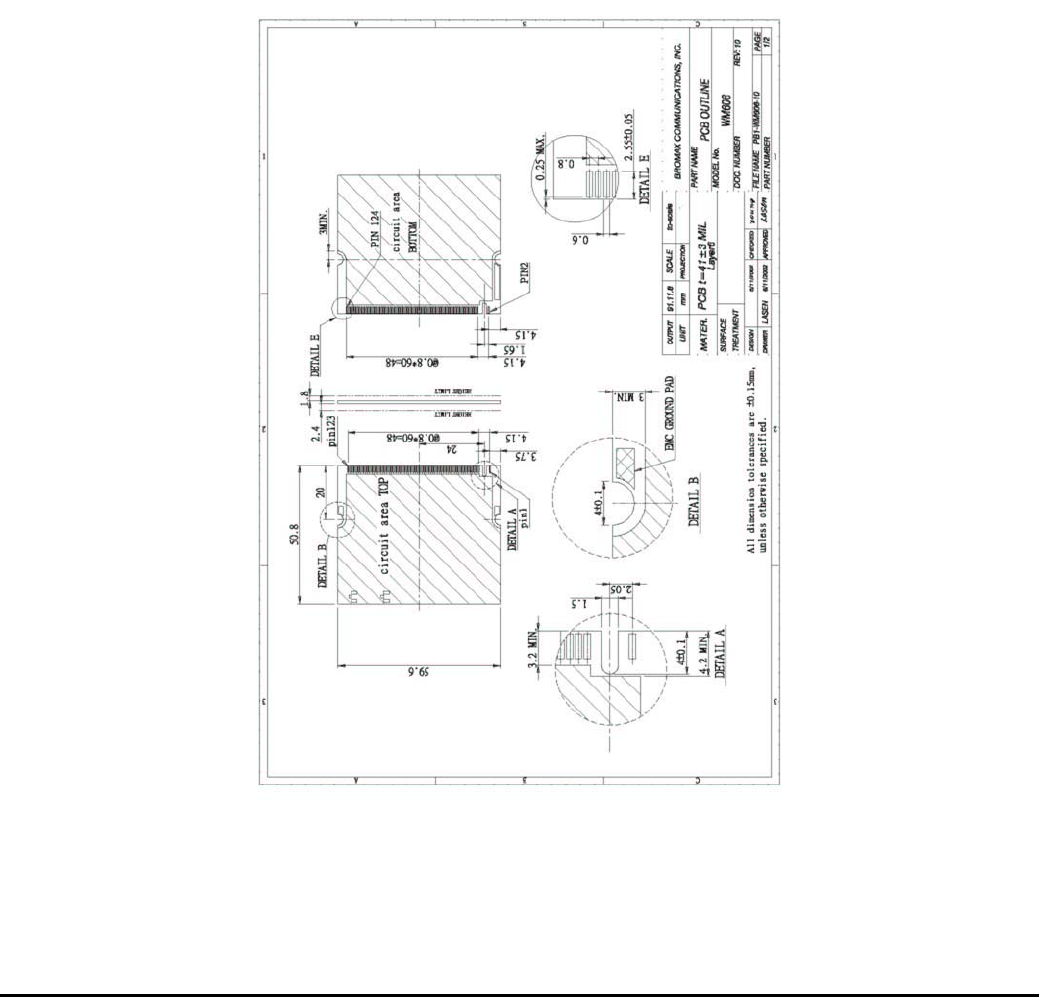
Chapter 2
Hardware installation
This chapter covers how to installing the Wireless MiniPCI Module in your embedded system.
Hardware description
The Wireless MiniPCI Module has a standard MiniPCI interface for attaching to the MiniPCI connec-
tor on embedded system.
And this module has IPEX connector to connect to external antenna.
Outlook
Following is the MiniPCI module outlook
Figure 1: MiniPCI module outlook
3
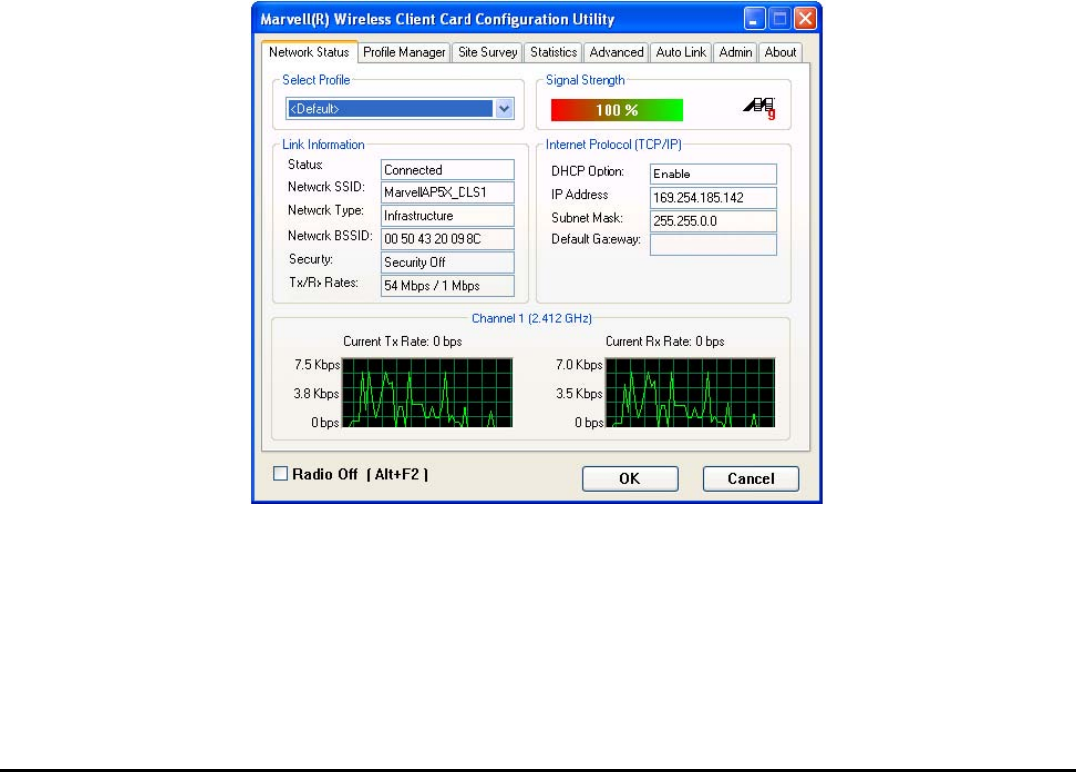
Chapter 3
Using the Wireless Utility
This module also come with a wireless utility, following describe how to use the utility.
Configuration Utility
The Client Card Configuration Utility allows configuration of WM821-M high throughput client cards through the following tabs:
• Network Status—displays the status of the network to which the
user is connected. The Configuration Utility
initializes on this page.
• Profile Manager—displays the current profiles and allows the user to set
attributes for network type, security options, and
protocols, as well as create/modify/delete profiles.
• Site Survey—displays site survey information.
• Statistics—displays the statistics of the current session.
• Advanced—used to set protocol parameters.
• AutoLink—to set AutoLink connection
• Admin—used to import and export profiles.
3.1 Network Status Tab
The Network Status tab displays the status of the network. When the Wireless client card Configuration Utility initializes, it displays
the Network Status tab.
Figure 2 :Network Status tab
3.1.1 Select Profile
The Select Profile section displays the name of the profile in use. Additional information about the profile is provided in the Profile
Manager.
Select one of the profiles previously defined by clicking the down arrow and highlighting a profile from the pull-down list.
Figure 3: Select Profile Section
4
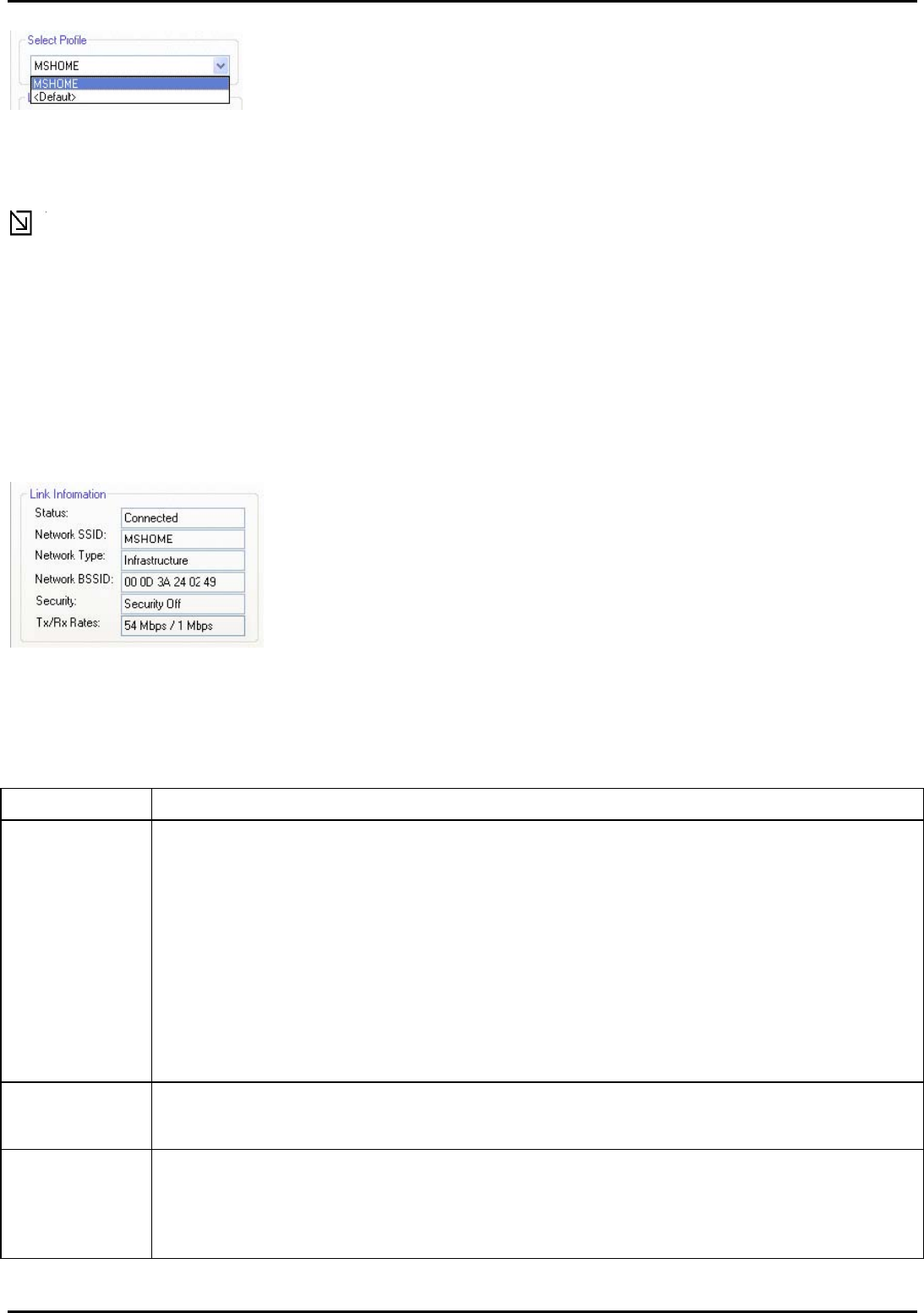
Appendix B Error Messages of Enabler Program
Figure 3: Select Profile
Profiles are created, modified, and deleted through the ProfileManager.
Note
This feature is disabled when Windows Zero Configuration Utility is enabled.
3.1.2 Link Information
The Link Information section contains the current information about the wireless connection. Figure 4: Link Information Sec-
tion
Figure 4: Link Information Section
Table 1:Link Information
Field Description
Status Status of the wireless network connection:
• Card Unplugged Client card is not plugged in, or client card is plugged in but not recognized.
• Connected
Client card is plugged in and connected to a wireless network.
• No Connection
Client card is plugged in, but no wireless connection.
• No Radio
Client card is plugged in, but the radio is turned off. Clear the Radio Off check box to turn the radio on.
• Scanning for Scanning for available APs and wireless stations in the area.
Network SSID Network SSID label (i.e., Network Name). The Network Name is a text string of up to
32 characters.
Network Type Type of environment connected to: • Infrastructure Mode In this mode, wireless clients send and receive in-
formation through APs. When a wireless client communicates with another, it transmits to the AP. First the AP
receives the information and rebroadcasts it, then other devices receive the information. The APs are strategi-
cally located within an area to provide optimal coverage for wireless clients. A large WLAN uses multiple APs to
provide coverage over a wide area. APs can connect to a LAN through a wired Ethernet connection. APs send
and receive information from the LAN through the wired connection.
5
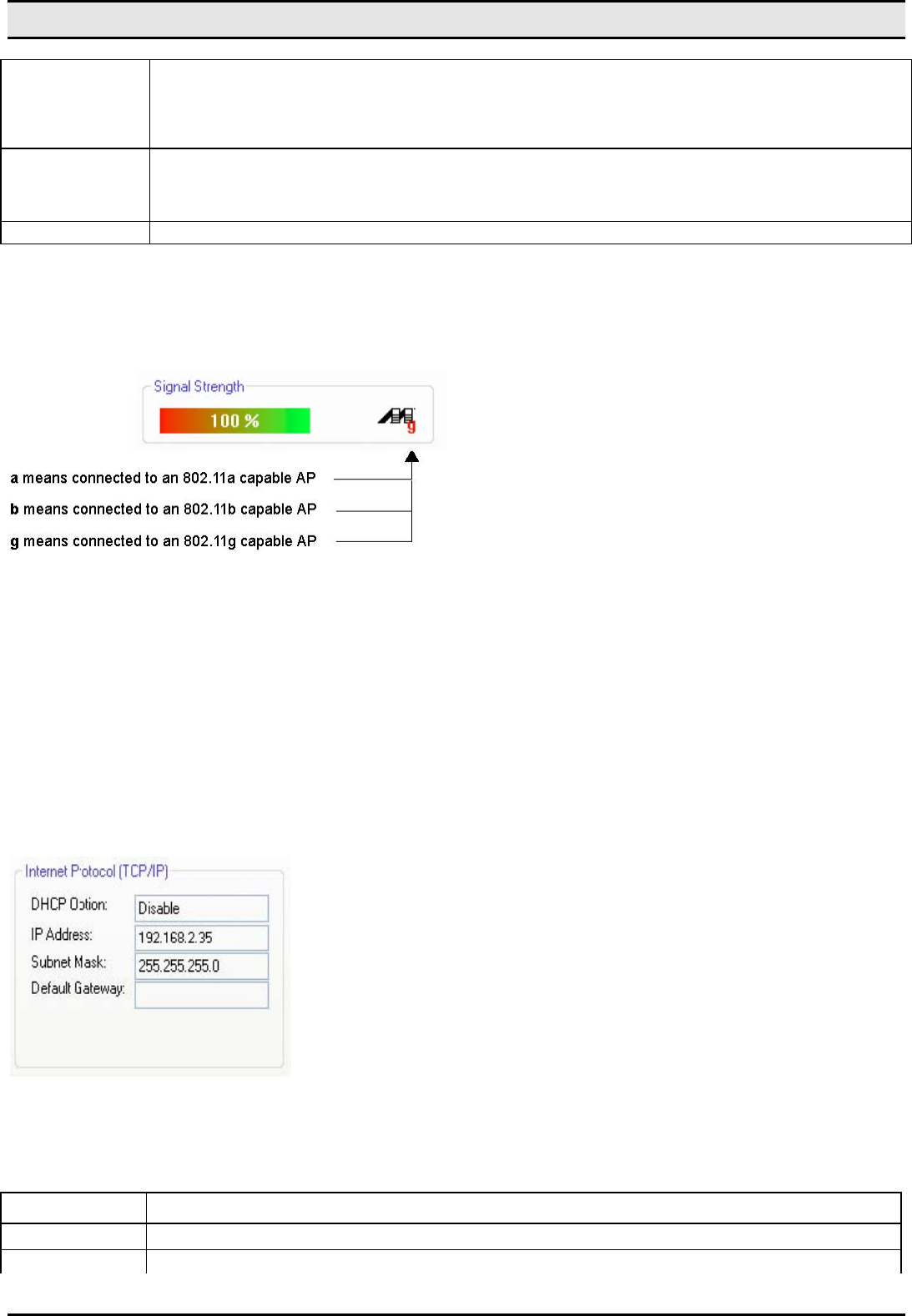
WM821-M MiniPCI Module —Using the Wireless Utility
Network BSSID Network Basic Service Set Identifier. The BSSID is a 48-bit identity used to identify a particular BSS within an
area. In Infrastructure BSS networks, the BSSID is the MAC
address of the AP. In independent BSS or Ad-Hoc networks, the BSSID is generated randomly.
Security Reports the type and level of security set. The security level is set through the Profile
Setting of the Profile Manager tab. Configure security settings also through the Site
Survey tab when connecting to a network.
Tx/Rx Rates Current Tx Rate and Rx Rate of the channel being monitored.
3.1.3 Signal Strength / Wireless Mode Indicator
The color-coded Signal Strength bar displays the signal strength of the last packet received by the client card.
Figure 5: Signal Strength
Signal strength is reported as a percentage. A signal in the red indicates a bad connection. A signal in the green indicates a good con-
nection.
The Wireless Mode indicator shows the data rates the client card operates. There are three modes:
. • 802.11a
. • 802.11b
. • 802.11g (backward compatible to 802.11b)
3.1.4 Internet Protocol (TCP/IP)
The Internet Protocol specifies the format of packets, also called data grams, and the addressing scheme. Most networks combine IP
with a higher-level protocol called TCP, which establishes a virtual connection between a destination and a source.
Figure 6:Internet Potocol Section
Table 2 Internet Protocol Section Description
Field Description
DHCP Option Dynamic Host Configuration Protocol. Either enabled or disabled.
IP Address An identifier for a computer or device on a TCP/IP network. The format of an IP address
6
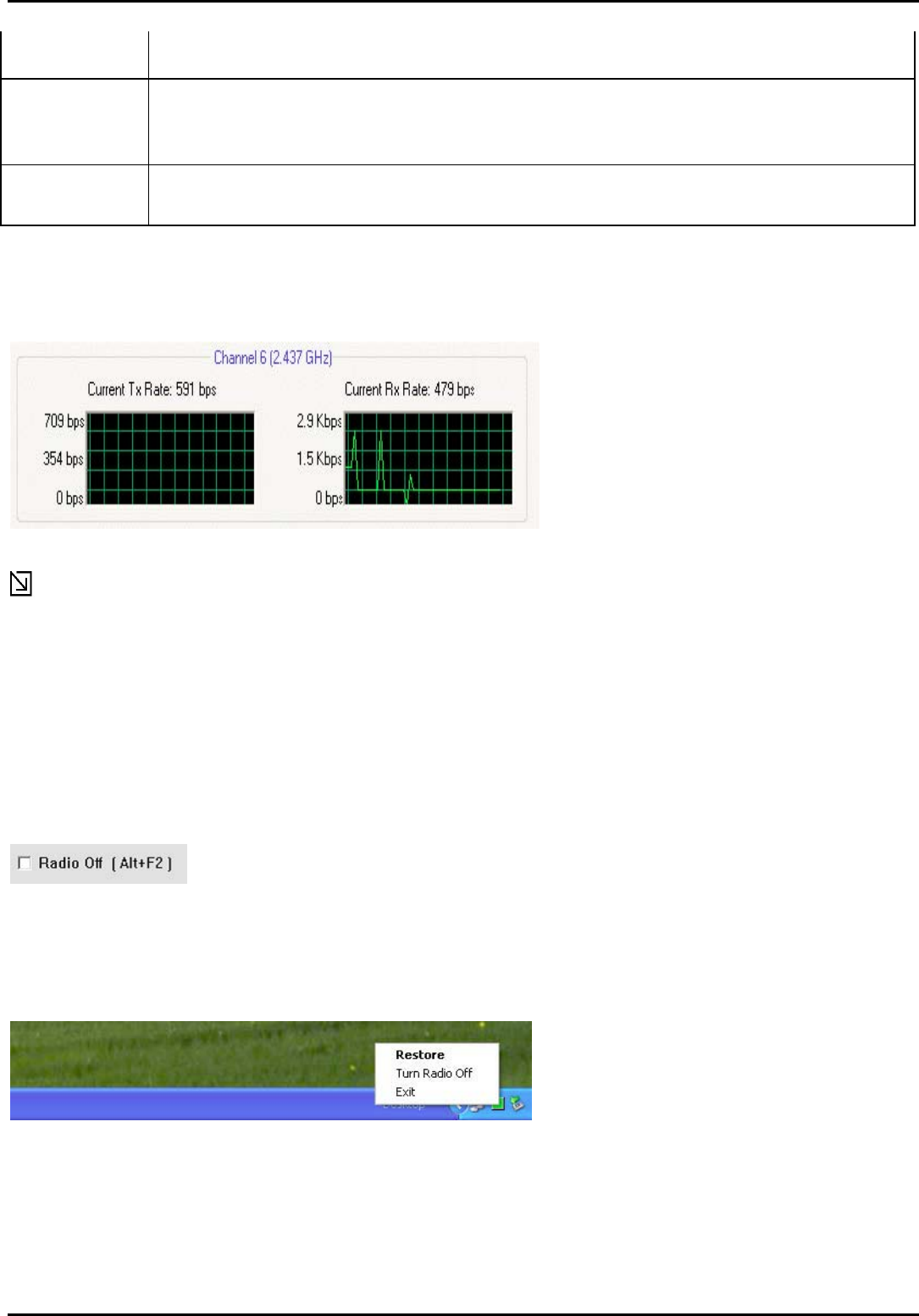
Appendix B Error Messages of Enabler Program
is a 32-bit numeric address written as four numbers separated by periods. Each number
can be 0 to 255.
Subnet Mask A mask used to determine what subnet an IP address belongs to. An IP address has two
components, the network address and the host address. The first two numbers represent the Class B network
address, and the second two numbers identify a particular host on
this network.
Default Gateway The default node on a network that serves as an entrance to another network. In enterprises, the gateway is
the computer that routes the traffic from a workstation to the outside network that is serving the Web pages. In
homes, the gateway is the ISP that connects the user to the Internet.
3.1.5 Actual Throughput Performance
This section of the Network Status tab displays the Current Tx Rate and the Current Rx Rate of the channel being monitored.
Figure 7: actual throughput diagrams
Note
These are actual throughput diagrams (without the WLAN overhead delivered by the client card).
3.1.6 Radio On/Off Check Box
Selecting the Radio Off check box turns off the radio. Clearing the check box turns on the radio. Figure 8: Radio On/Off
Check Box
Figure 8:Radio On/Off Check Box
Another way to turn the radio on or off is to right-click the Configuration Utility icon in System Tray and select Turn Radio Off to
turn the radio off. When the radio is off, select Turn Radio On to turn the radio back on.
Figure 9: Radio On/Off in the System Tray
The system hot key Alt+F2 can also be used to turn the radio on/off.
When the radio is off, there is no radio activity, and the following tabs are disabled:
. • Profile Manager
. • Site Survey
7
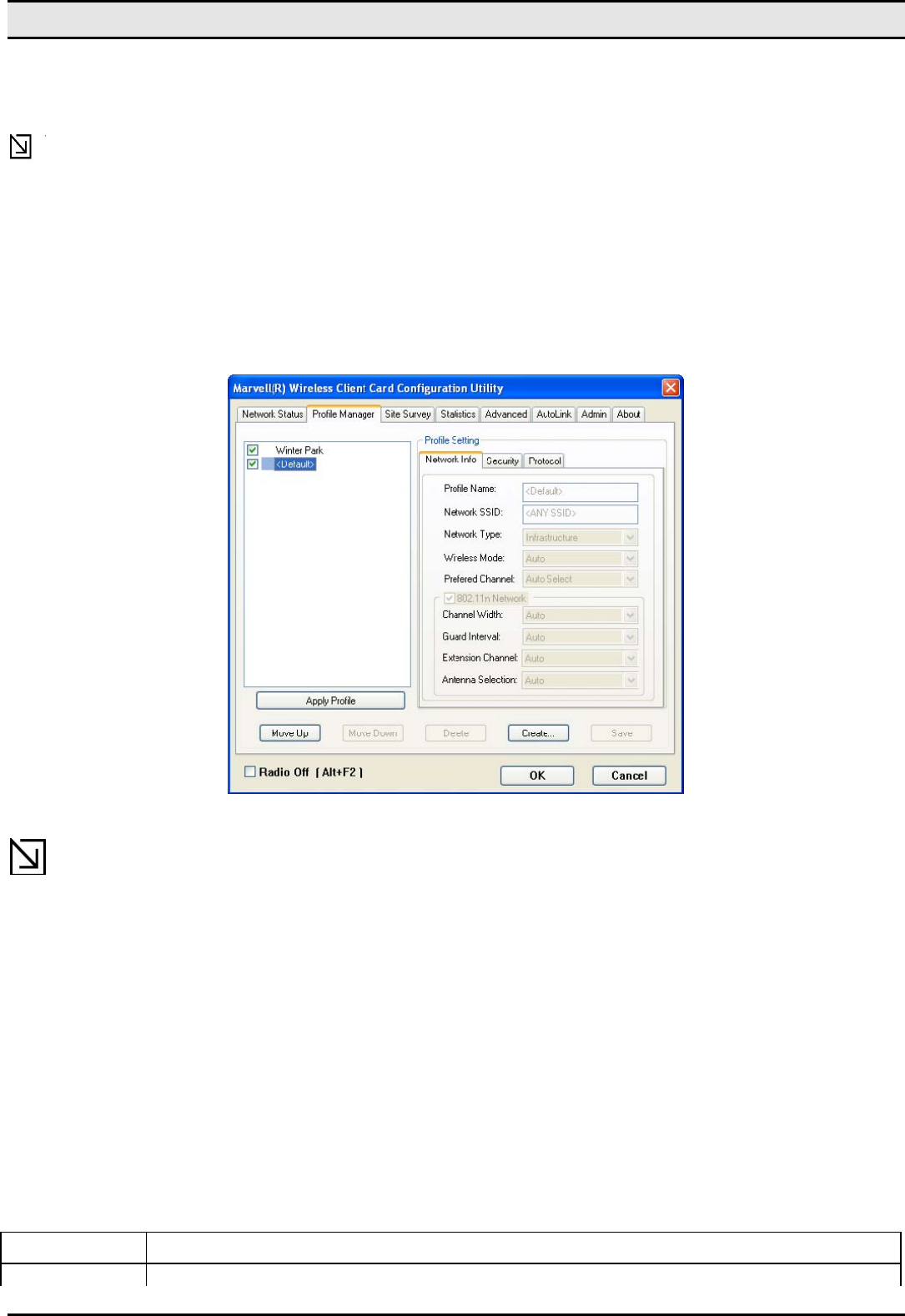
WM821-M MiniPCI Module —Using the Wireless Utility
. • Statistics
. • Advanced
. • AutoLink
Note
This feature is disabled when Windows Zero Configuration Utility is enabled.
3.2 Profile Manager Tab
The Profile Manager tab displays the profiles available and allows you to create, modify, and delete profiles.
Figure 10: Figure 14: Profile Manager Tab
Note
The Profile Manager tab is not accessible when Windows Zero Configuration Utility is enabled.
PROFILE MANAGER—PROFILE LIST
The section on the left side of this tab lists all of the profiles available. Highlighting a profile selects it. If the check box next to the pro-
file is selected, that profile is used in auto-configuration mode when the link is lost. If it is not selected, that profile is excluded in auto-
configuration. The buttons associated with this window are as follows.
Table 3: Profile List Section Description
Button Description
Apply Profile Applies the profile selected.
8
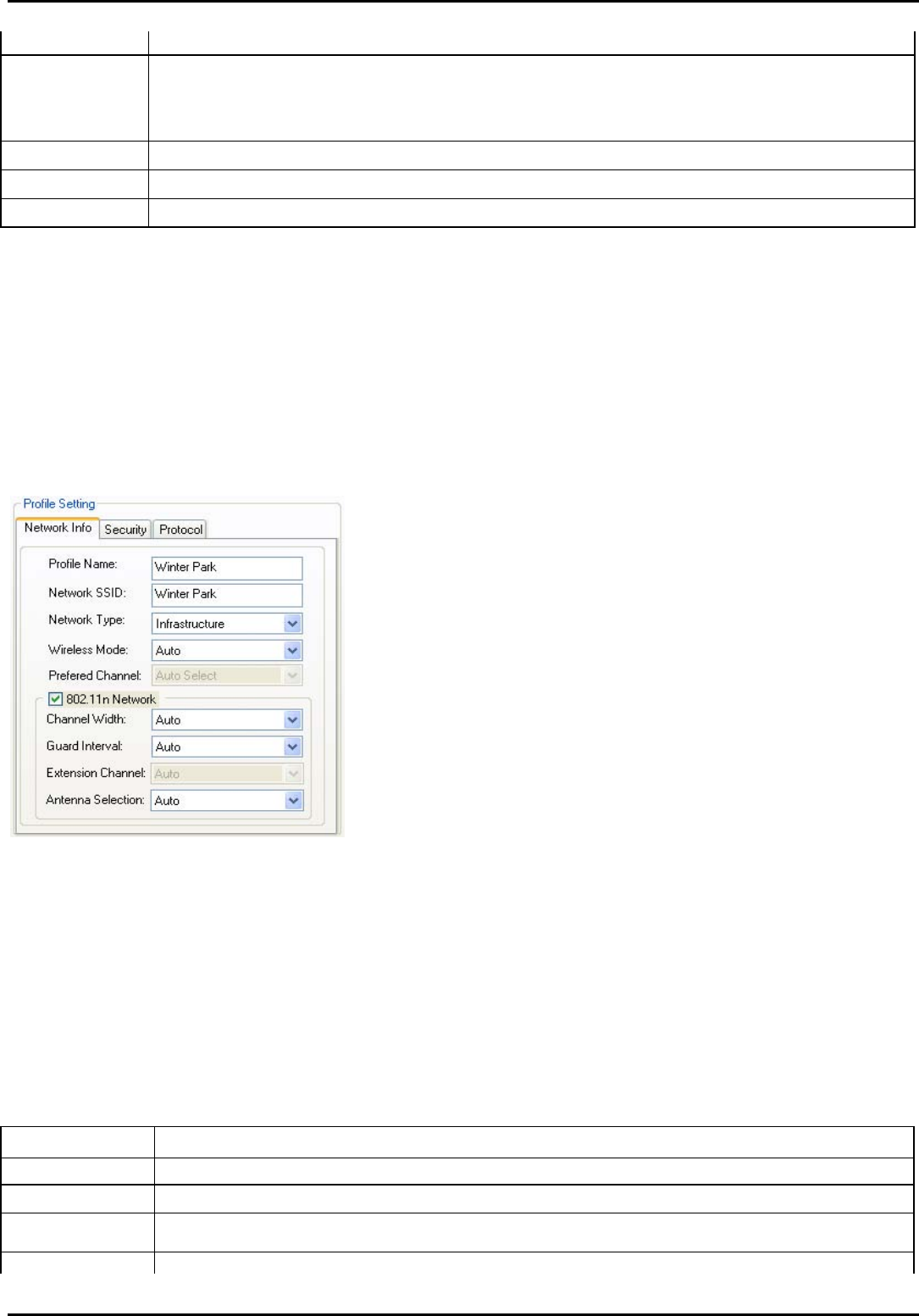
Appendix B Error Messages of Enabler Program
Apply the profile by double-clicking the desired profile.
Move Up / Down Moves the list up and down in the window.
All profiles with the Network Type set to Infrastructure are displayed before the profiles with the Network Type
set to Ad-Hoc. In auto-configuration mode, the selected profiles at the top of the list have higher priority than
selected profiles at the bottom of the list.
Delete Deletes a profile
Create Creates a profile
Save Saves changes made to a selected profile
PROFILE MANAGER—PROFILE SETTING The Profile Settings are used to set, modify, and display information about the pro-
file selected in the Profile List section. The information is divided into three tabs:
. • Network Info
. • Security
. • Protocol
3.2.1 Profile Setting—Network Info Tab
The Profile Manager initially displays the Network Info tab.
Figure 11: Network Info Tab (Infrastructure Network)
The Network Info tab fields are as follows.
Table 4: Network Info Tab Description
Field Description
Profile Name Name of profile selected
Network SSID Network SSID label
Network Type • Infrastructure When an Infrastructure network is selected, the Profile Setting displays the Wireless Mode
field.
Wireless Mode • Auto
9
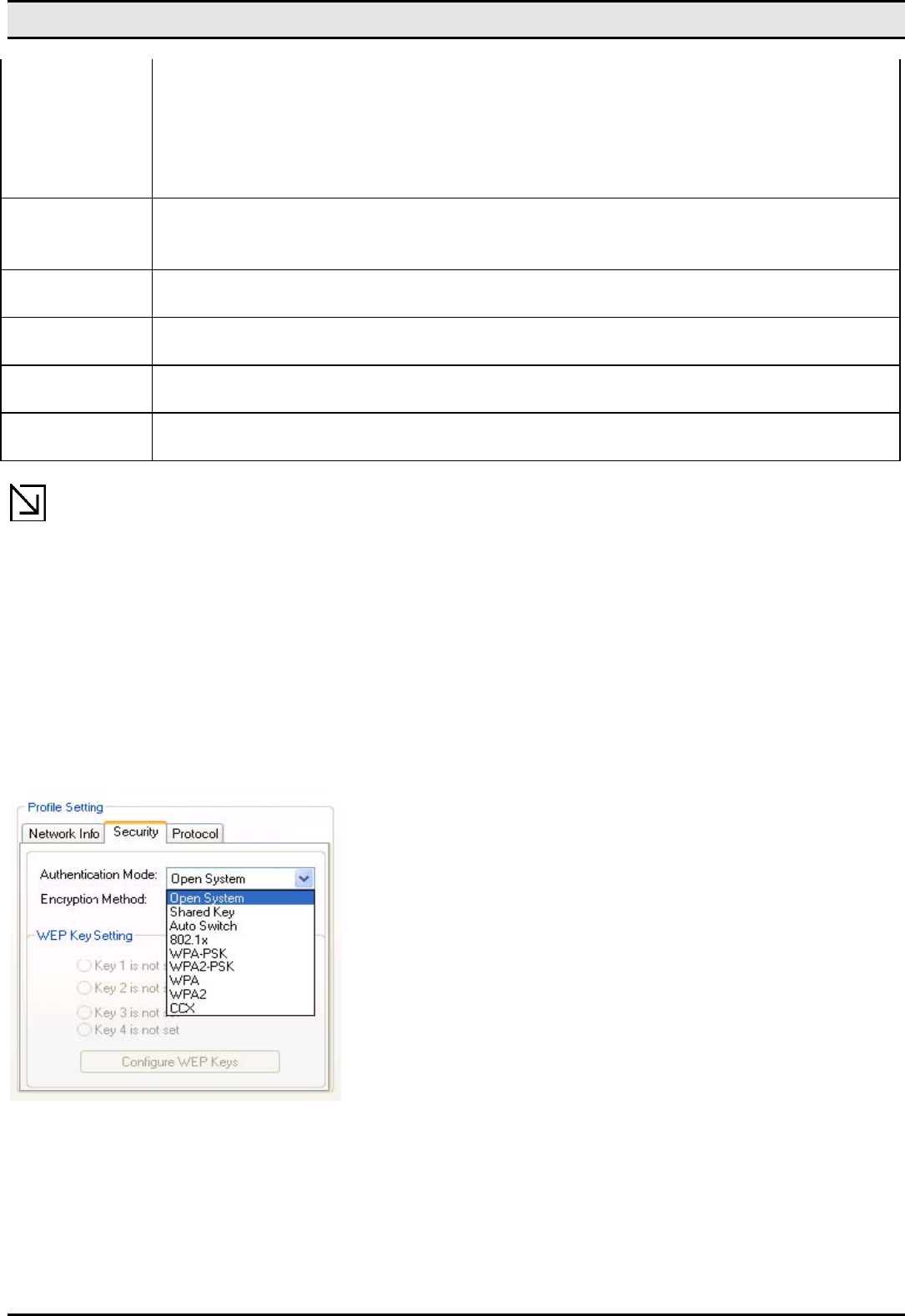
WM821-M MiniPCI Module —Using the Wireless Utility
Connects to 802.11a network, 802.11g network, or 802.11b network (Infrastructure network only).
• 802.11a
Connects to 802.11a only.
• 802.11g Connects to either 802.11g network or 802.11b network.
• 802.11b
Connects to 802.11b network only.
802.11n Network Enables/disables draft-802.11n/EWC functionality.
If enabled, the Modulation and Coding Scheme (MCS) index and 802.11n options can
be configured.
Channel Width Sets the channel bandwidth. Available options are Auto, 20 MHz, and 40 MHz.
The default is Auto.
Guard Interval Sets the Guard Interval. Available options are Auto, Standard, and Short.
The default is Auto.
Extension Channel Sets the extension channel mode when bandwidth is 40 MHz. Available options are
Auto, None, Lower, and Upper. The default is Auto.
Antenna Selection Sets the antenna selections. Available options are Auto, Antenna A, Antenna B, 2 by 2,
and 2 by 3. The default is Auto.
Note
The fields Wireless Mode and Preferred Channel are used only when an Ad-Hoc network is
started by the client card. These two attributes are ignored if the client card is connected to an exist-
ing Ad-Hoc network with the same desired SSID.
3.2.2 Profile Setting—Security Tab
Clicking the Security tab displays the following security options:
. • Authentication Mode
. • Encryption Mode (Security off, WEP, TKIP, and AES)
. • WEP Key Setting (Passphrase Key or Authentication Protocol)
Figure 12: Security tab
3.2.2.1 Non-EAP Authentication Modes
The WM821-M Configuration Utility currently supports the following non-EAP authentication modes:
. • Open System—Open Authentication (no key or a pre-shared WEP key is
. required).
. • Shared Key—Shared Authentication (a pre-shared WEP key is required)
10
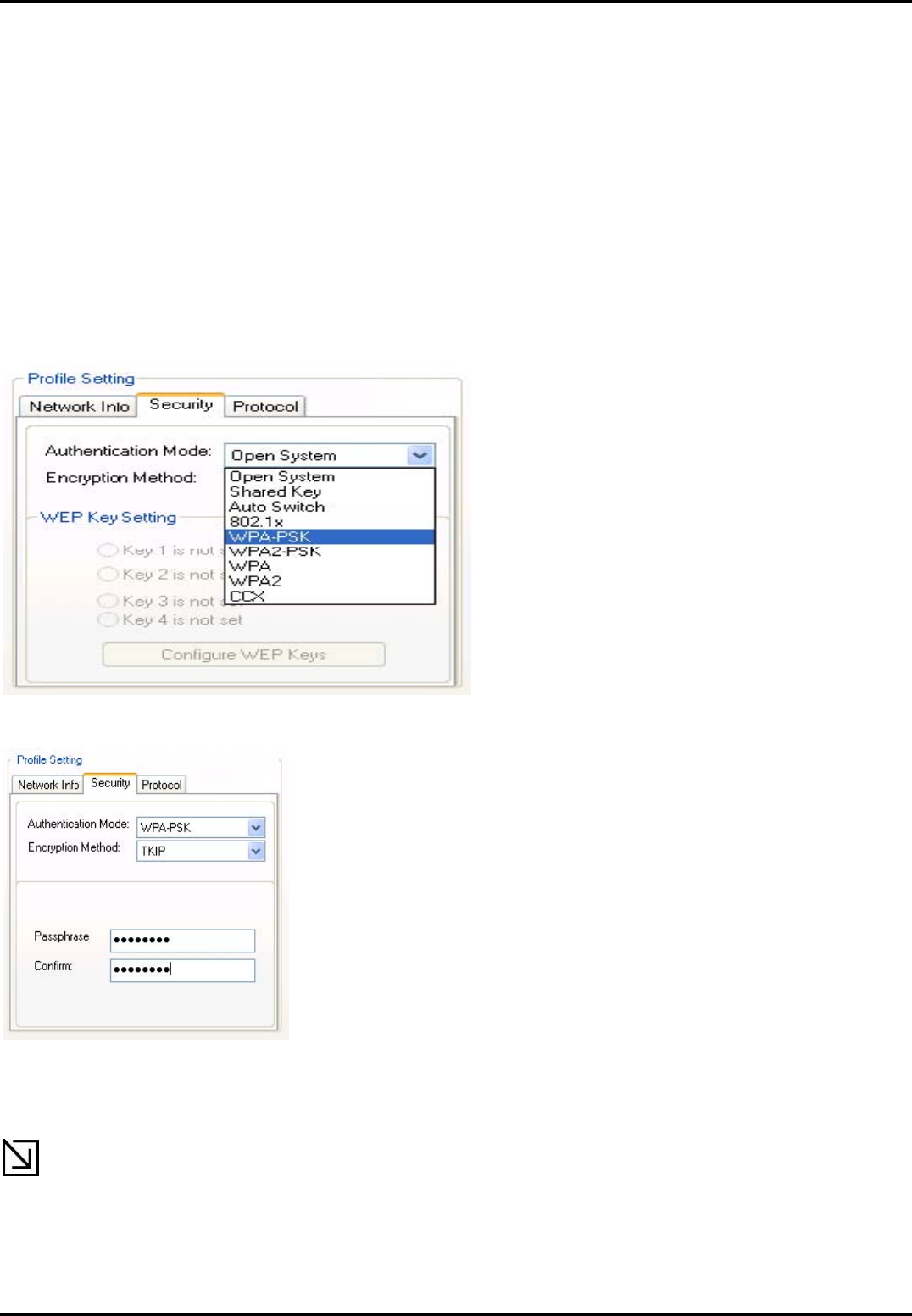
Appendix B Error Messages of Enabler Program
. • Auto Switch—Auto Select Authentication modes (Open System or Shared
. Key, WEP key required)
. • WPA-PSK—WPA Pre-Shared Key
. • WPA2-PSK—WPA2 Pre-Shared Key
3.2.2.2 EAP Authentication Modes
The WM821-M Configuration Utility currently supports the following EAP authentication modes:
. • 802.1x (TLS/PEAP)
. • WPA (TLS/PEAP/LEAP)
. • WPA2 (TLS/PEAP/LEAP)
. • CCX (LEAP)
3.2.2.2.1 WPA-PSK/WPA2-PSK SUPPORT
In Infrastructure mode, if WPA-PSK/WPA2-PSK is selected as the Authentication Mode, the encryption method AES or TKIP can be
selected.
Figure 13: Security selection
Figure 14: Security Tab—WPA-PSK/WPA2-PSK with TKIP
Enter the network passphrase into the Passphrase and Confirm boxes.
Note
WPA-PSK/WPA2-PSK is not supported in Ad-Hoc network mode.
3.2.2.2.2 802.1X/WPA/WPA2 EAP/TLS SUPPORT
If the 802.1x EAP/TLS option is selected, the encryption method AES or TKIP can be selected, and a certificate is required for the
authentication.
11
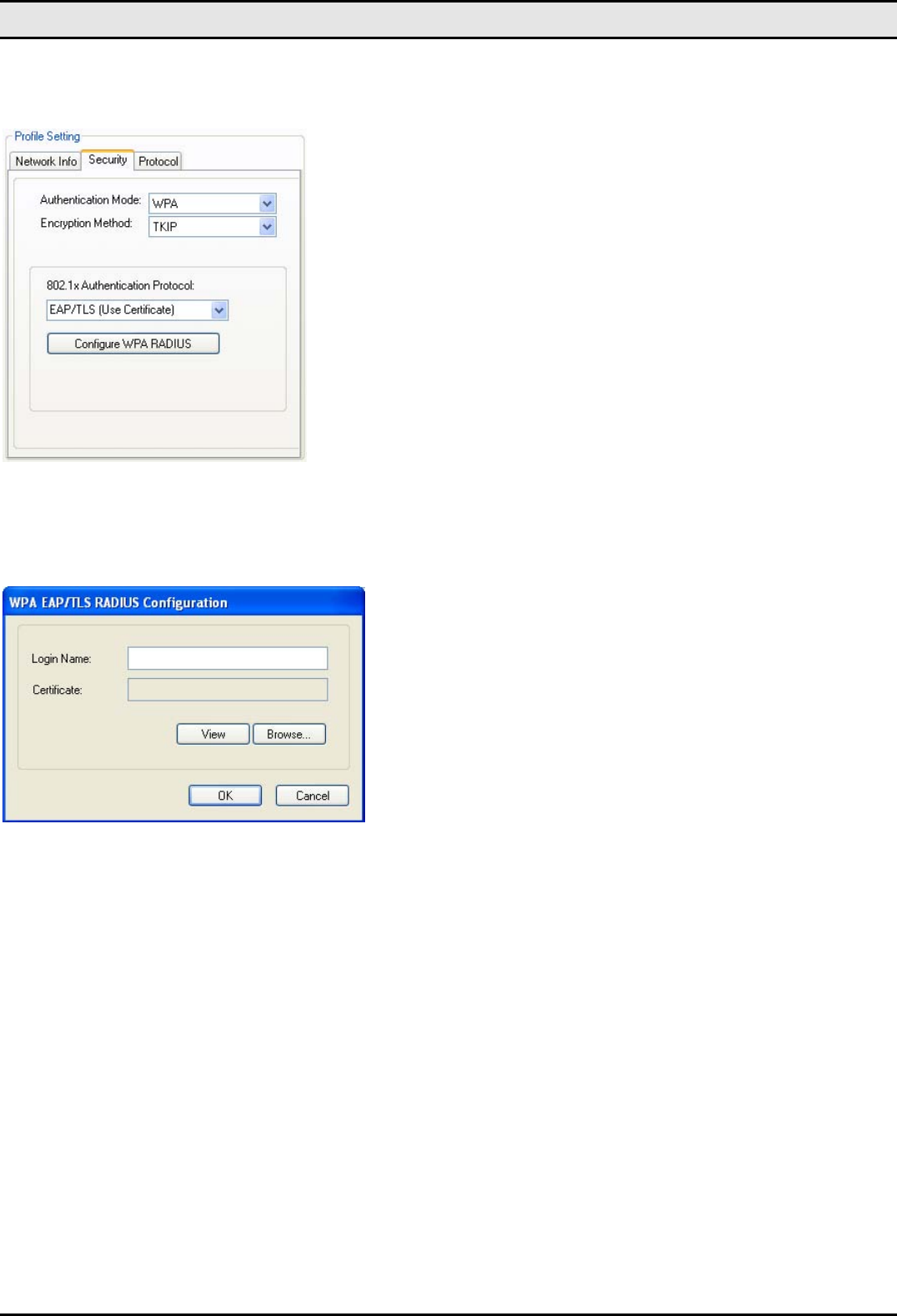
WM821-M MiniPCI Module —Using the Wireless Utility
1. 1. To connect to an AP through the RADIUS server, select 802.1x WPA/WPA2 as the Authentication Mode.
2. 2. Select TKIP or AES as the Encryption Method.
3. 3. Select EAP/TLS (Use Certificate) as the 802.1x Authentication Protocol.
Figure 15: Security Tab—802.1x/WPA/WPA2 EAP/TLS Authentication
4. Click the Configure WPA RADIUS button to configure security settings.
Figure 16: 802.1x/WPA/WPA2 EAP/TLS RADIUS Configuration Window
1. 5. Click Browse to activate the dialog for selecting a certificate.
2. 6. Before clicking OK to exit the dialog, make sure that the Login Name is entered.
12
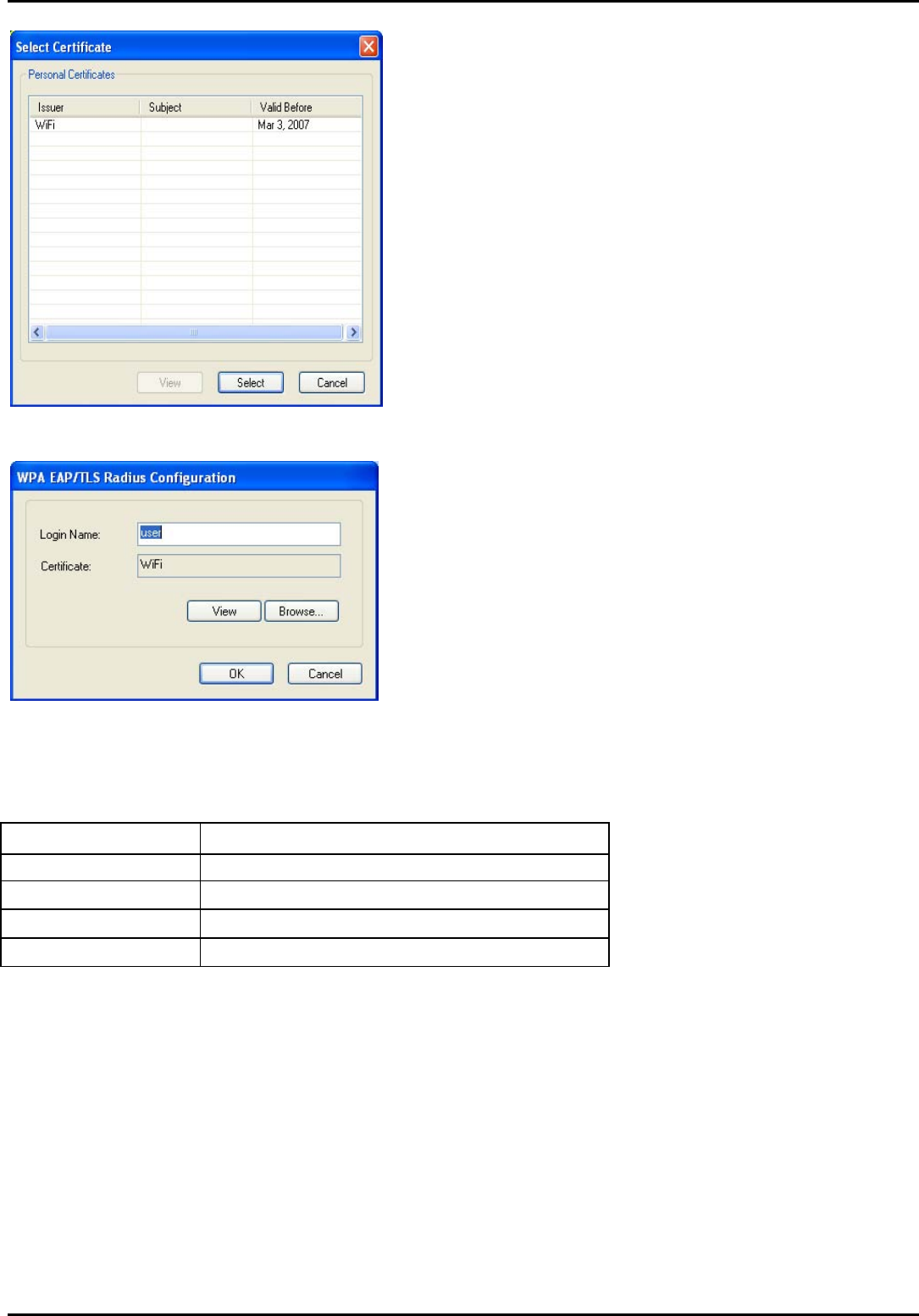
Appendix B Error Messages of Enabler Program
Figure 17: Select Certificate
Figure 18: WPA RADIUS Configuration Window with Certificate
Table 5: 802.1x/WPA/WPA2 EAP/TLS RADIUS Configuration Window Description
Field/Button Description
Login Name Login name to the RADIUS server
Certificate Certificate selected for authentication
View Shows the selected certificate
Browse Selects the certificate
3.2.2.2.3 802.1X/WPA/WPA2 PEAP SUPPORT IN INFRASTRUCTURE MODE
To connect to an AP through the RADIUS server, select 802.1x/WPA/WPA2 as the Authentication Mode, PEAP as the Authentication
Protocol, and AES or TKIP as the Encryption Method.
13
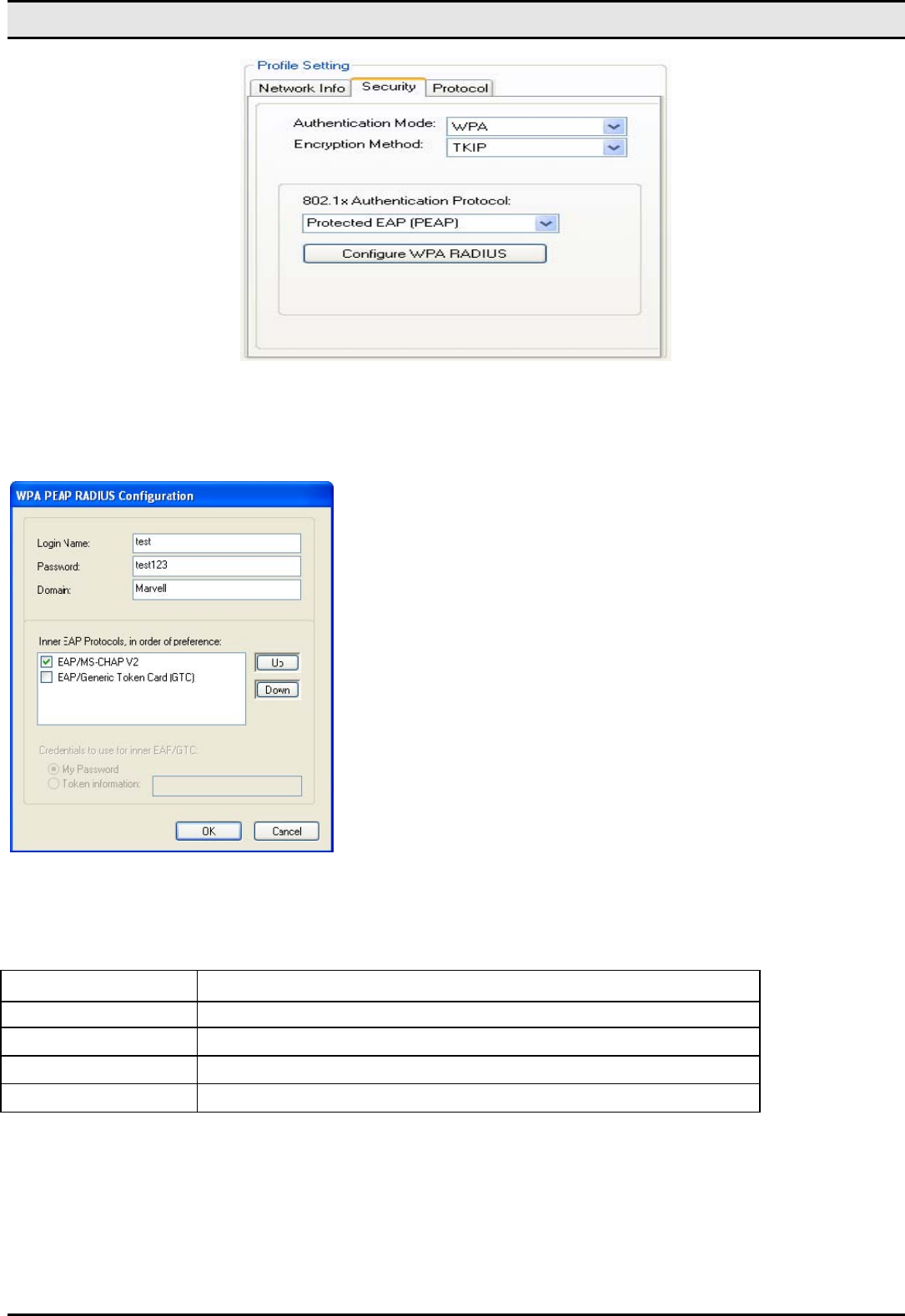
WM821-M MiniPCI Module —Using the Wireless Utility
Figure 19:Security tab 802.1x/WPA/WPA2 PEAP RADIUS Authentication
Figure 25: 802.1x/WPA/WPA2 PEAP RADIUS Configuration Window
Figure 20: 802.1x/WPA/WPA2 PEAP RADIUS Configuration Window
Table 6: WPA PEAP RADIUS Configuration Window Description
Field Description
Login Name Login name to the RADIUS server
Password Password to login to the RADIUS server
Domain Domain name for login to the RADIUS server (optional)
Inner EAP Protocol Use EAP/MS-CHAP V2 or EAP/GTC to login to the RADIUS server
Click OK to set the configuration.
3.2.2.2.4 WPA/WPA2 EAP/TTLS
To connect to an AP through the RADIUS server, select WPA/WPA2 as the Authentication Mode, TTLS as the 802.1x Authentication
Protocol, and TKIP as the Encryption Method for WPA TTLS or AES as the Encryption Method for WPA2 TTLS.
14
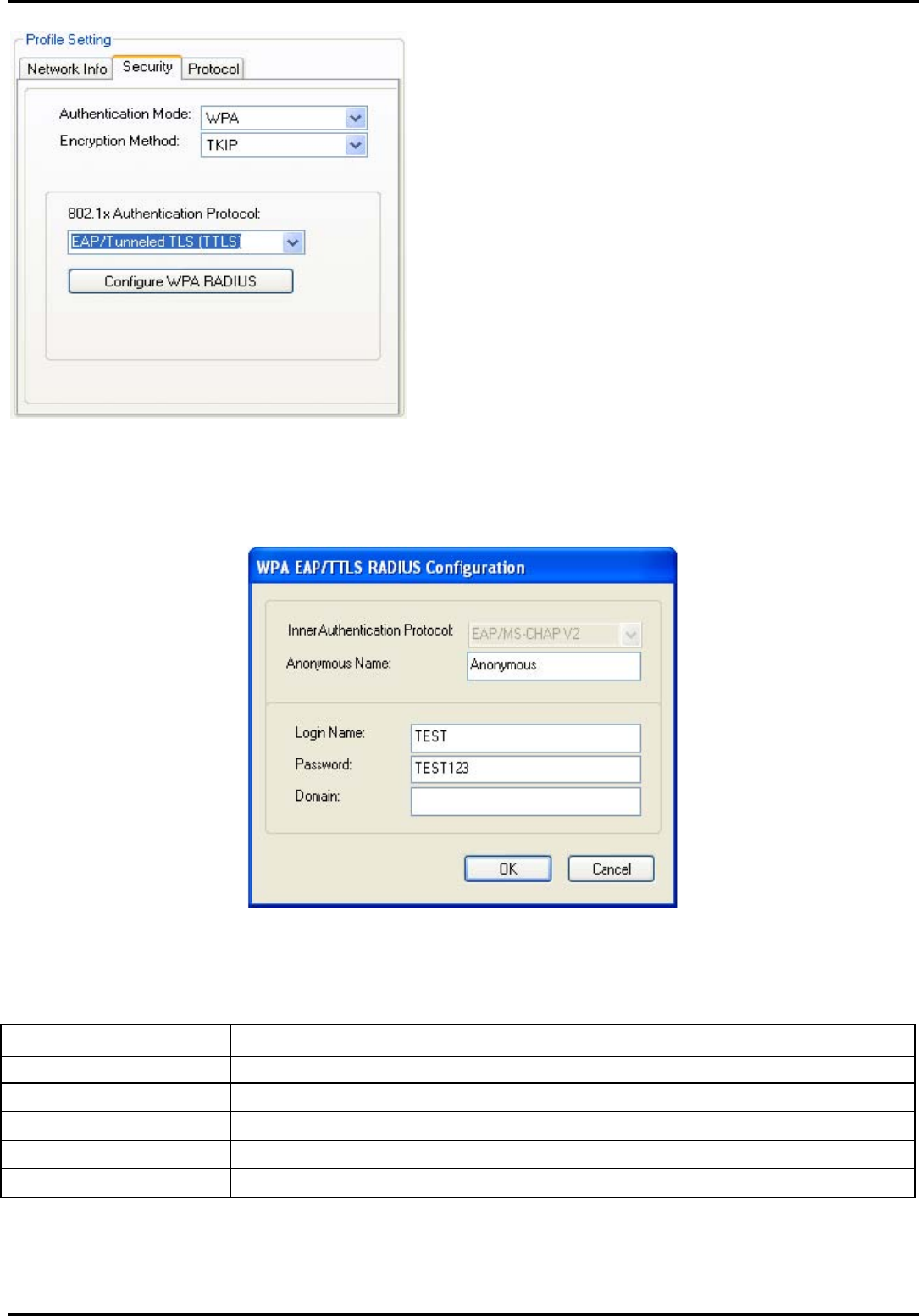
Appendix B Error Messages of Enabler Program
Figure 21: WPA/WPA2 EAP/TTLS Authentication
Clicking the Configure WPA RADIUS button displays the WPA EAP/TTLS RADIUS Configuration window. Enter all the required
information.
Figure 22:WPA EAP RADIUS Configuration window
Table 7: WPA TTLS RADIUS Configuration Window Description
Field Description
Inner Authentication Protocol Currently supports EAP/MS-CHAP V2 only
Anonymous Name Indicates the identity of the authentication server with which to make contact
Login Name Login name to the RADIUS server
Password Password to login to the RADIUS server
Domain Domain name for login to the RADIUS server (optional)
Click OK to set the configuration.
3.2.2.2.5 CCX EAP/LEAP
15
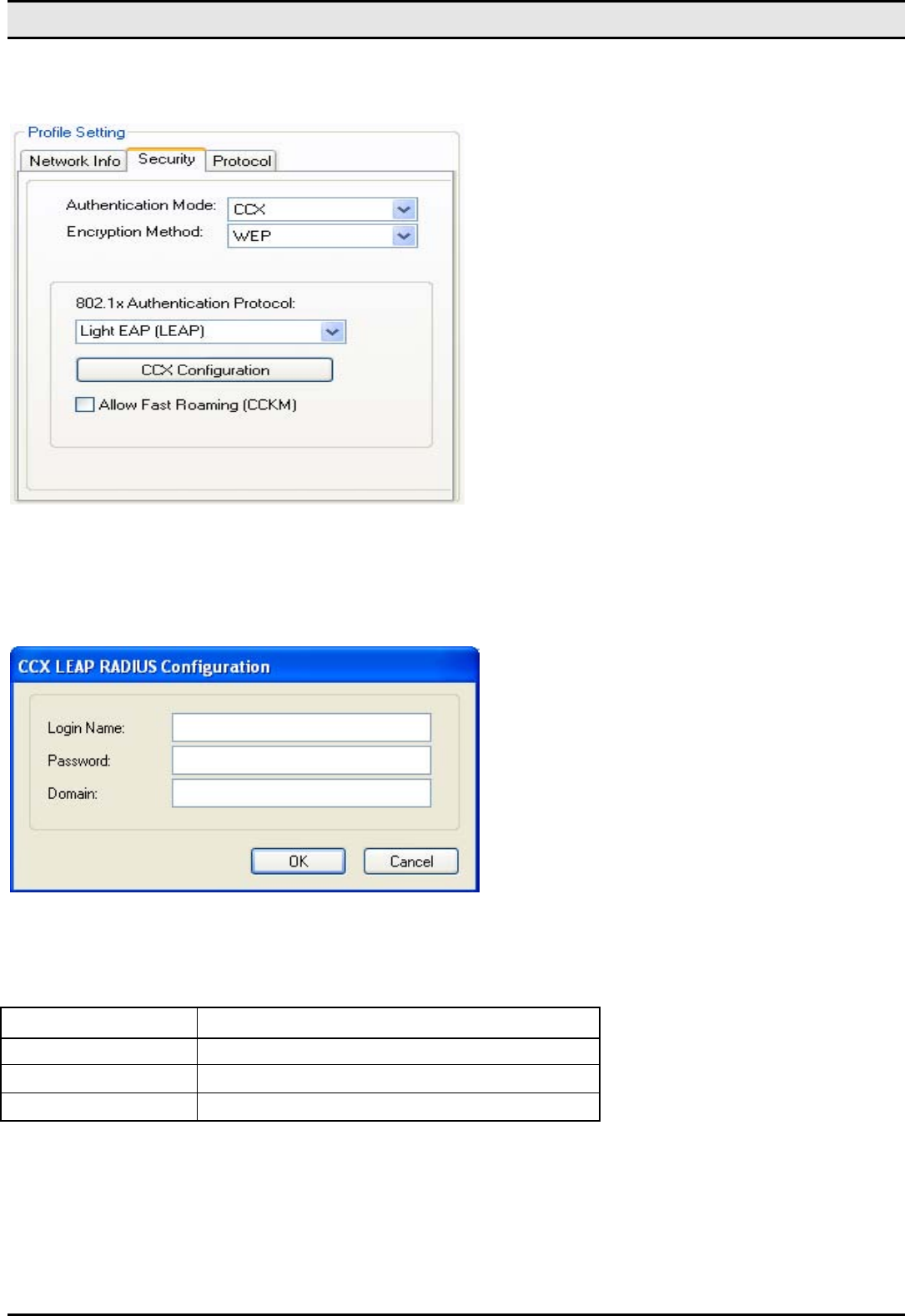
WM821-M MiniPCI Module —Using the Wireless Utility
To connect to a Cisco AP through the RADIUS server, select CCX EAP/LEAP. WEP is the Encryption Method, and the key is gener-
ated automatically.
Figure 23: Security Tab-CCX EAP/LEAP Authentication
If Allow Fast Roaming (CCKM) is selected, Fast Roaming (Cisco Centralized Key Management (CCKM)) is enabled.
Clicking the CCX Configuration button displays the CCX LEAP RADIUS Configuration window. Enter all the required information.
Figure 24: CCX EAP/LEAP RADIUS Configuration Window
Table 8: CCX EAP/LEAP RADIUS Configuration Window Description
Field Description
Login Name Login name to the RADIUS server
Password Password to login to the RADIUS server
Domain Domain name for login to the RADIUS server (optional)
Click OK to set the configuration.
3.2.2.3 Encryption Methods
The following encryption methods are available, depending on the authentication mode:
. • Security Off
. • WEP
16

Appendix B Error Messages of Enabler Program
. • TKIP
. • AES
3.2.2.4 WEP Key Settings
If the WEP Encryption Method is selected, the Security tab displays the WEP Key Setting. To configure the WEP keys, select the
WEP Key Setting, and click the Configure WEP Keys button.
Note
The WEP key used for the transmission must be identical on the sending and the receiving station.
Figure 25: Security Tab-WEP Key Settings
Clicking the Configure WEP Keys button displays the Configure WEP Key window. Enter all the required information.
Figure 26: WEP Key Configuration Window
17
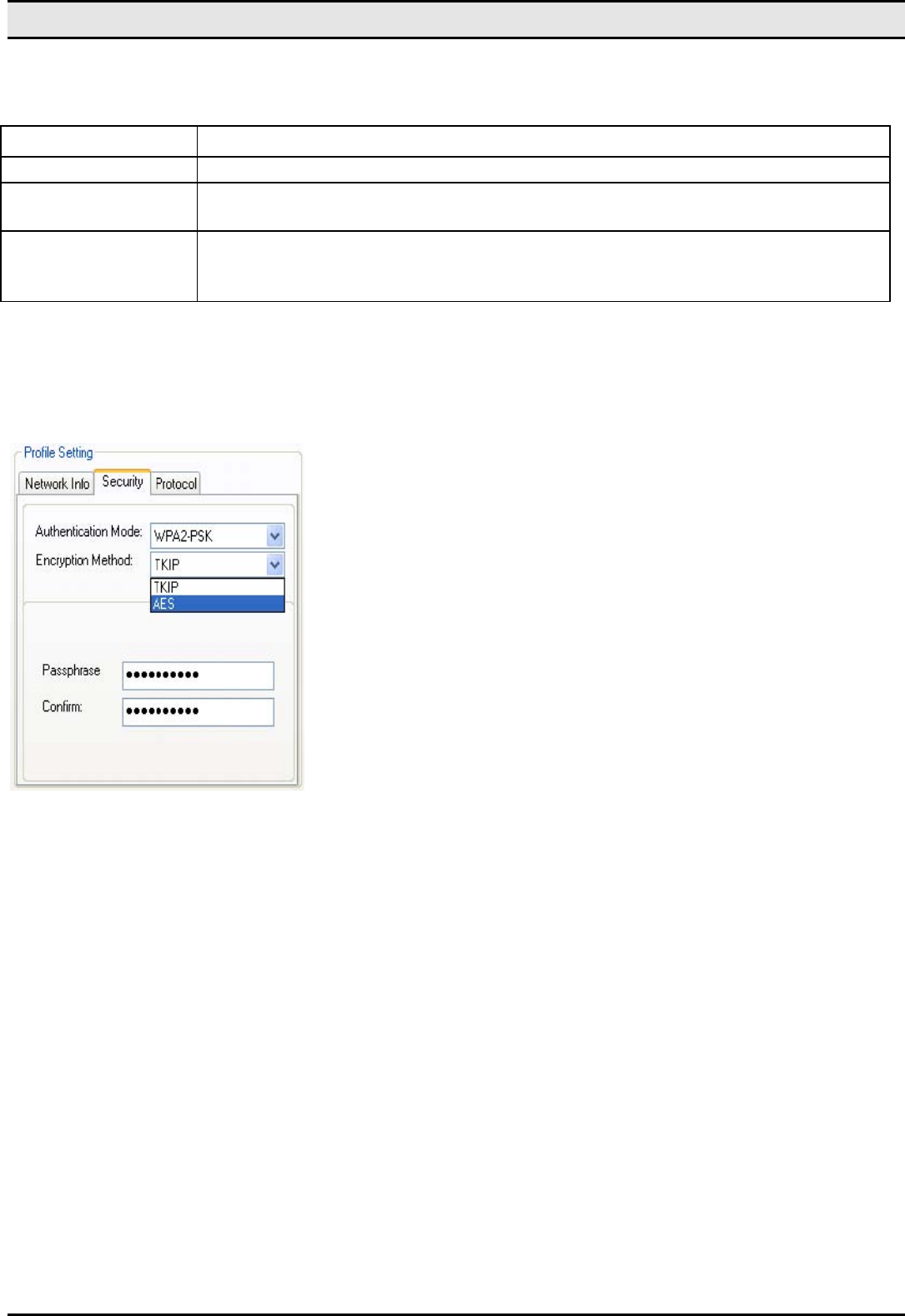
WM821-M MiniPCI Module —Using the Wireless Utility
Table 9: WEP Key Configuration Window Description
Field Description
Key Format Either ASCII characters or hexadecimal digits
Key Size • 40-bit, 5 character ASCII key size (40-bit, 10 character hexadecimal) • 104-bit, 13 character ASCII
key size (104-bit, 26 character hexadecimal)
Transmit Keys There are four transmit keys. The key value is in ASCII or hexadecimal,
depending on the format selected. The WEP key size shown depends on the key
size selected.
Click OK to set the configuration.
3.2.2.5 TKIP/AES Settings
If TKIP/AES is selected and the Authentication Mode is WPA-PSK or WPA2-PSK, the security tab displays the TKIP/AES passphrase
settings. Enter the passphrase into the Passphrase and Confirm boxes, and click OK.
Figure 27: TKIP/AES Settings
Currently, only the functions WPA-PSK + TKIP and WPA2-PSK + AES are available. There is no such combination as WPA-PSK +
AES or WPA2-PSK + TKIP.
3.2.3 Profile Setting—Protocol Tab
The Protocol tab allows you to set or change the protocol information.
18

Appendix B Error Messages of Enabler Program
Figure 28: Protocol Tab
DO NOT CHANGE SETTINGS
If this check box is selected, the protocol setting is not changed when the profile is applied.
USE BELOW SETTINGS If the Do not change setting check box is not selected, the protocol settings include the following pa-
rameters.
Table 10: Protocol Tab Description
Field Description
Power Save Mode Sets the power mode. Available options are Continuous Access or Max Power Save. The default set-
ting is Continuous Access.
Preamble (802.11b) Sets the Radio Preamble to Auto, Short or Long. This option takes effect only when attaching to an
802.11b network.
Transmit Rate The range of the data rate depends on the type of AP that the client card is connected to. The default
setting is Auto Select. MCS index will be allowed to select when the 802.11n Network check box in the
Network Info tab is selected.
Fragment Threshold Sets the fragmentation threshold (the size that packets are fragmented into for transmission). The de-
fault setting is 2346.
Region Code Sets the region code. Available options are FCC (U.S.), IC (Canada), ETSI (Europe), Spain, France,
and MKK (Japan).
RTS/CTS Threshold Sets the packet size at which the AP issues a Request-To-Send (RTS) or Clear-to-Send (CTS) frame
before sending the packet. The default setting is 2347.
Reset Resets the protocol settings to their default values
3.3 Site Survey Tab
19
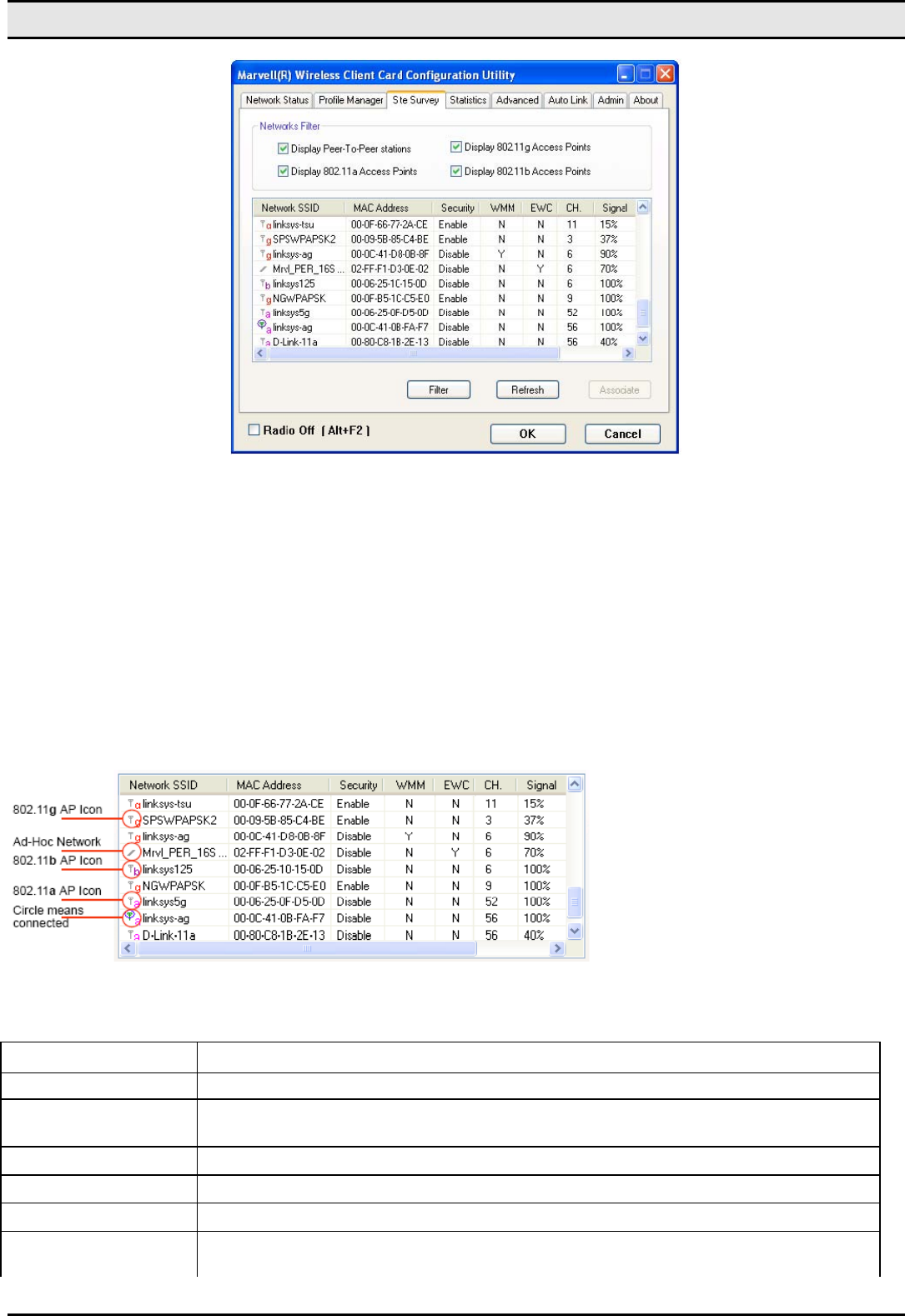
WM821-M MiniPCI Module —Using the Wireless Utility
Figure 29: Site Survey Tab
3.3.1 Site Survey—Networks Filter
This section lets you customize which sites are displayed in the Site Survey list:
. • Display Peer-To-Peer stations—selecting this check box displays all peer-to-peer (Ad-Hoc) stations within range.
. • Display 802.11a Access Points—selecting this check box displays all 802.11a APs within range.
. • Display 802.11g Access Points—selecting this check box displays all 802.11g APs within range.
. • Display 802.11b Access Points—selecting this check box displays all 802.11b APs within range.
3.3.2 Site Survey—List of Detected Stations
This section reports information on the AP stations detected.
Figure 30: Site Survey-List of Detected Stations
Table 11: List of Detected Stations Description
Field Description
Network SSID Network SSID label (i.e., the Network Name). The Network Name is a text string.
MAC Address MAC address, a hardware address that uniquely identifies each node of a
network
Security Security enabled or disabled
CH Channel used by the detected device
Signal Signal strength of the detected device as a percentage
Icons The following icons may be displayed left of the Network SSID: • An antenna icon with a subscript a
indicates an 802.11a AP.
20
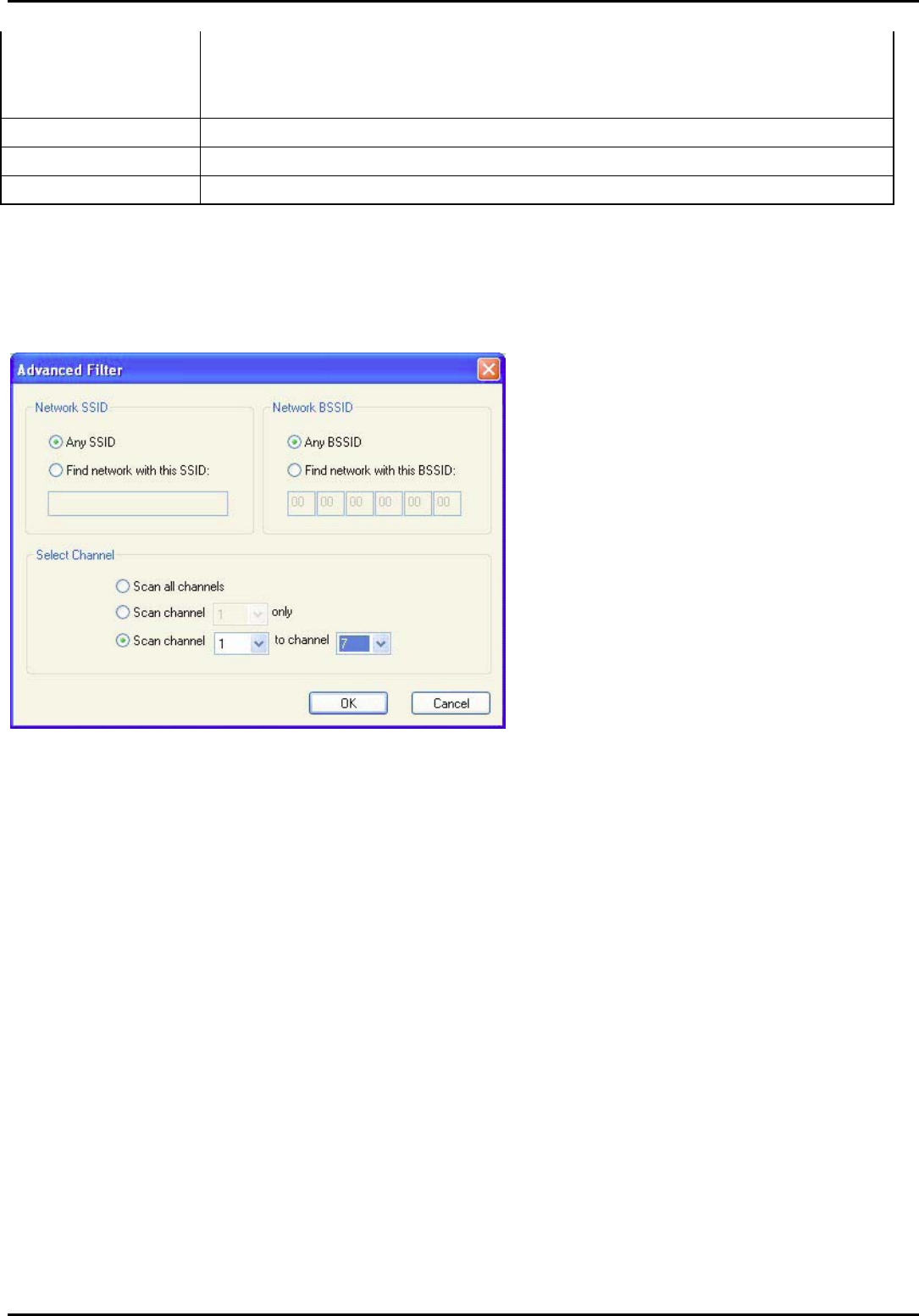
Appendix B Error Messages of Enabler Program
• An antenna icon with a subscript b indicates an 802.11b AP.
• An antenna icon with a subscript g indicates an 802.11g AP. • A circle around the antenna icon
means the client card is connected to this
network.
WMM Wireless Multimedia Enhancements (WMM) supported by the detected device
EWC Draft-802.11n/EWC functionality supported by the detected device
Network Type Type of environment connected to: Ad-Hoc or Infrastructure
3.3.3 Site Survey—Filter Button
Clicking the Filter button displays the Advanced Filter window.
Figure 31: Figure 36: Site Survey—Advanced Filter Window
3.3.3.1 Network SSID
. • Any SSID—no specific SSID is used when scanning for available networks in the area.
. • Find network with this SSID—the utility searches for the specified SSID.
3.3.3.2 Network BSSID
. • Any BSSID—no specific BSSID is used when scanning for available networks in the area.
. • Find network with this BSSID—the utility searches for the specified BSSID.
3.3.3.3 Select Channel
. • Scan all channels—all channels are scanned when searching for available networks in the area.
. • Scan channel Only—only the specified channel is scanned when searching for available networks in the area.
. • Scan Channel to Channel—a range of channels are scanned when searching for available networks in the area.
3.3.4 Site Survey—Refresh Button
Clicking the Refresh button requests a survey of the wireless networks in the area.
3.3.5 Site Survey—Associate Button
Select an available network, and then click the Associate button to establish a connection. Alternatively, the connection can be estab-
lished by double-clicking the selected network.
21
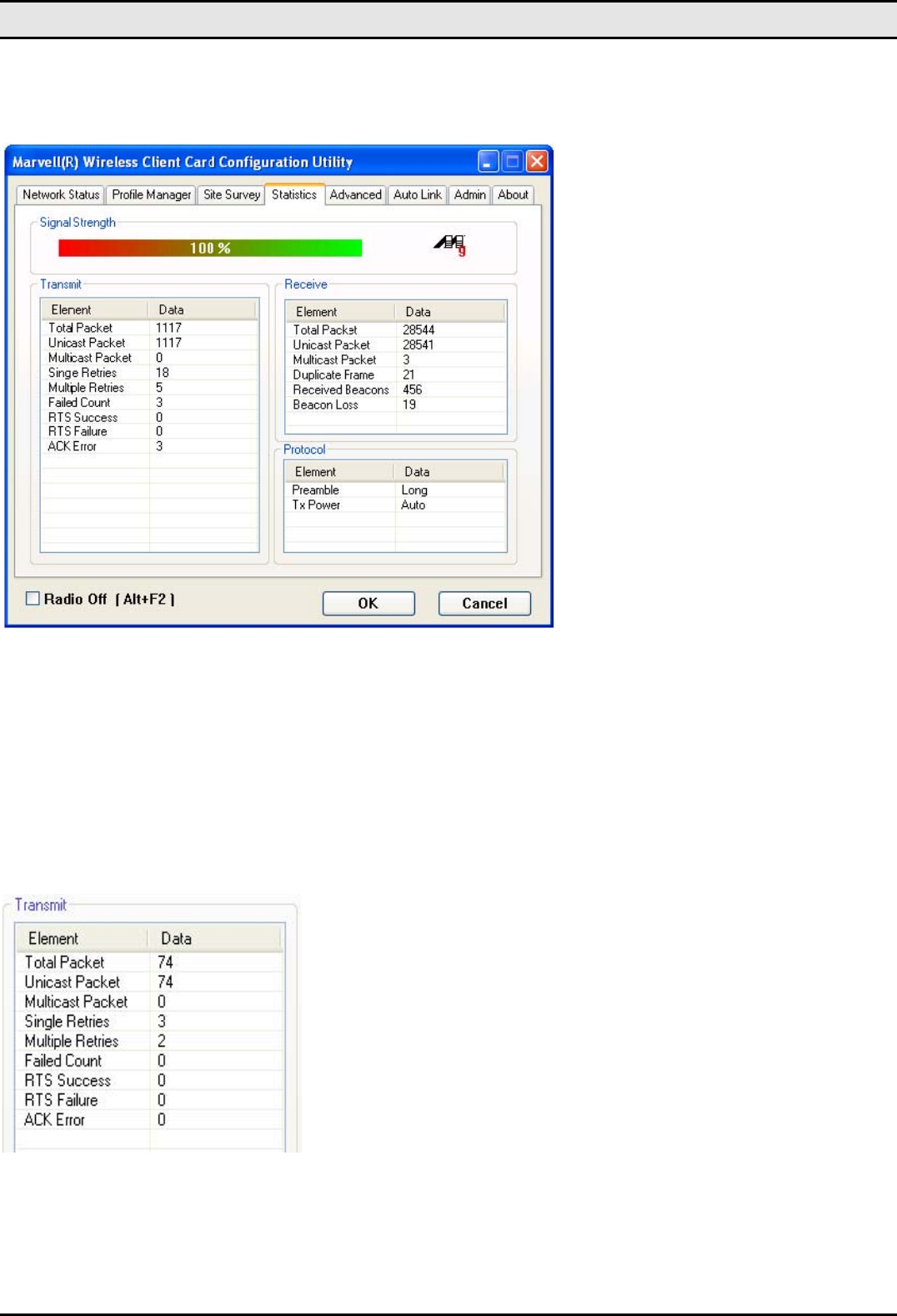
WM821-M MiniPCI Module —Using the Wireless Utility
3.4 Statistics Tab
Clicking the Statistics tab displays the statistics of the current connect session.
Figure 32: Statistics Tab
3.4.1 Signal Strength
The color-coded Signal Strength bar displays the signal strength of the last packet received by the client card. Signal strength is re-
ported as a percentage. A signal in the red indicates a bad connection. A signal in the green indicates a good connection.
3.4.2 Transmit Section
The Transmit section displays the information on the packets sent.
Figure 33: Transmit Section
22
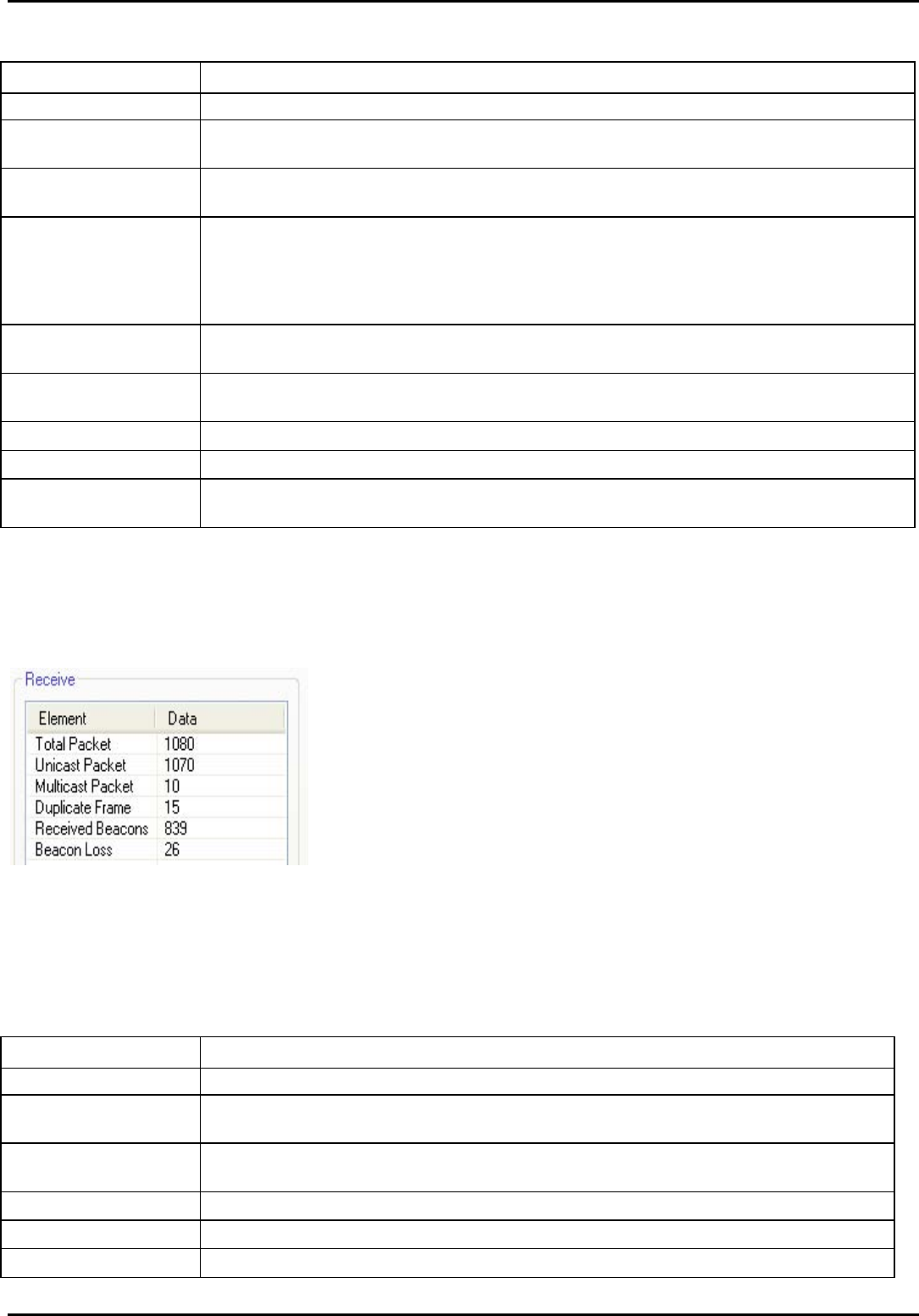
Appendix B Error Messages of Enabler Program
Table 12: Transmit Section Description
Field Description
Total Packet Reports the total number of packets transmitted
Unicast Packet Reports the number of packets transmitted by the client card that were destined
for a single network node
Multicast Packet Reports the number of packets transmitted by the client card that were destined
for more than one network node
Single Retries Reports the number of packets that require one retry before the client card received an acknowledge-
ment.
NOTE:After the client card sends a packet, it waits for an acknowledge from the receiving radio to con-
firm that the packet was successfully received. If the acknowledge is not received within a specified
period of time, the client card retransmits the packet.
Multiple Retries Reports the number of packets that require more than one retry before the client
card received an acknowledgement
Failed Count Reports the number of packets that were not successfully transmitted because
the client card did not receive an acknowledge within the specified period of time
RTS Success Reports the number of RTS attempts that were successful
RTS Failure Reports the number of RTS attempts that were not successful
ACK Error Reports the number of unicast transmit attempts for which no acknowledgement
was received
3.4.3 Receive Section
The Receive section displays the information on the packets received.
Figure 34: Receive Section
Table 13: Receive Section Description
Field Description
Total Packet Reports the total number of packets received
Unicast Packet Reports the number of packets received by the client card that were destined for
a single network node
Multicast Packet Reports the number of packets received by the client card that were destined for
more than one network node
Duplicate Frame Reports the number of duplicate frames received
Received Beacons Reports the number of beacons received after association is established
Beacon Loss Reports the number of missing beacons after association is established
23

WM821-M MiniPCI Module —Using the Wireless Utility
3.4.4 Protocol Section
The Protocol section displays the information on the protocol status. Figure 40: Protocol Section
Figure 35: Protocol Section
Table 14: Protocol Section Description
Field Description
Preamble Displays radio preamble type: • Auto
• Short
• Long
Tx Power Displays transmit power mode: • Auto
• High
• Medium
• Low
3.5 Advanced Tab
The Advanced tab displays the advanced parameters available for the installed WM821-M client cards.
24
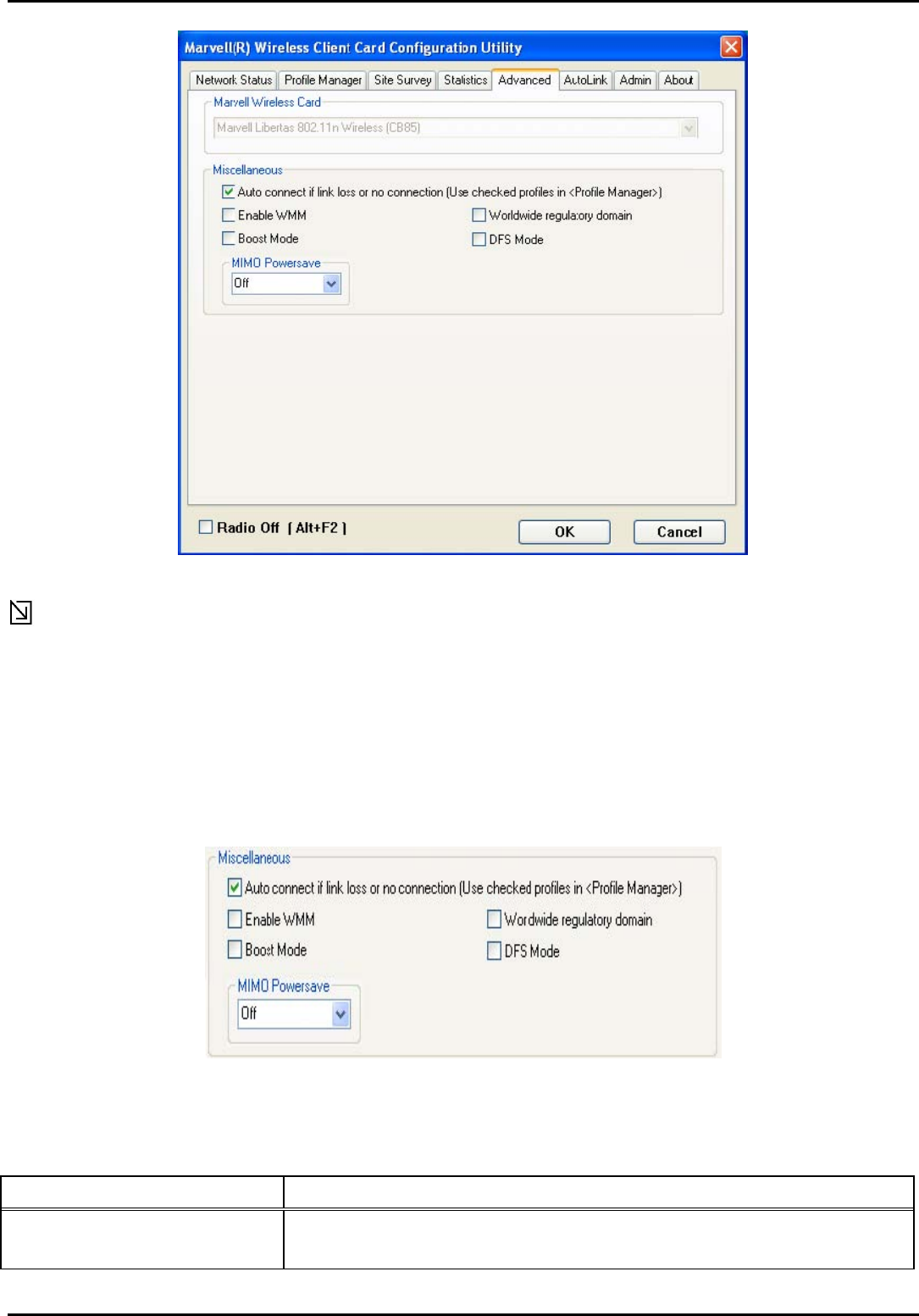
Appendix B Error Messages of Enabler Program
Figure 36: Advanced Tab
Note The Advanced tab is not accessible when the Windows Zero Configuration Utility is enabled.
3.5.1 Advanced Tab—WM821-M Wireless Card
This section of the Advanced tab reports the type of WM821-M client card installed.
3.5.2 AdvancedTab—Miscellaneous
Figure 37: Miscellaneous Section
Table 15: Advanced Tab Miscellaneous Section Description
Field Description
Auto connect if link loss or no connec-
tion (Use checked profiles in <Profile
Manager>)
Clear this check box to disable the auto-configuration feature. Whenever there is a link
loss, auto-configuration tries to establish a connection to the checked profiles in the Profile
Manager window.
25
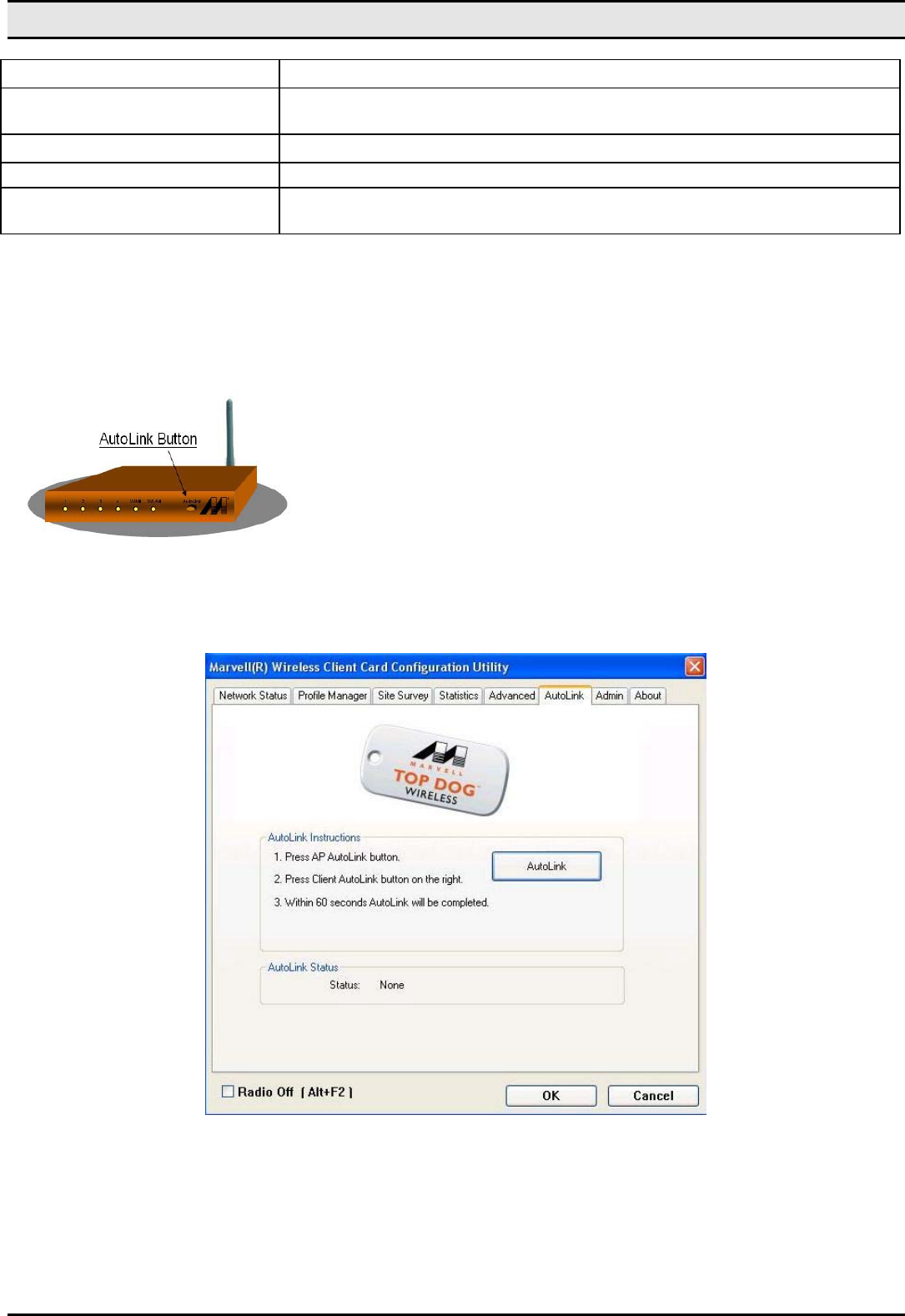
WM821-M MiniPCI Module —Using the Wireless Utility
Boost Mode Select this check box for performance enhancement.
Enable WMM Select this check box to enable/disable the Wireless Multimedia Enhancements (WMM)
feature.
Worldwide regulatory domain Select this check box to set the regulatory domain
DFS Mode Select this check box to enable Dynamic Frequency Selection (DFS)
MIMO Powersave Enables/disables the Multiple Input Multiple Output (MIMO) Powersave Mode. Available
options are Off and Static.
3.6 AutoLink Tab
To enable AutoLink mode, proceed as follows:
1. 1. Toggle the AutoLink button on the Access Point to enable AutoLink mode.
2. 2. Toggle the AutoLink button on the client to enter AutoLink mode.
Figure 38: Access Point Autolink Button
Within 60 seconds, the AutoLink will be completed.
Figure 39: Auto Link Tab (Client)
AutoLink is complete.
26
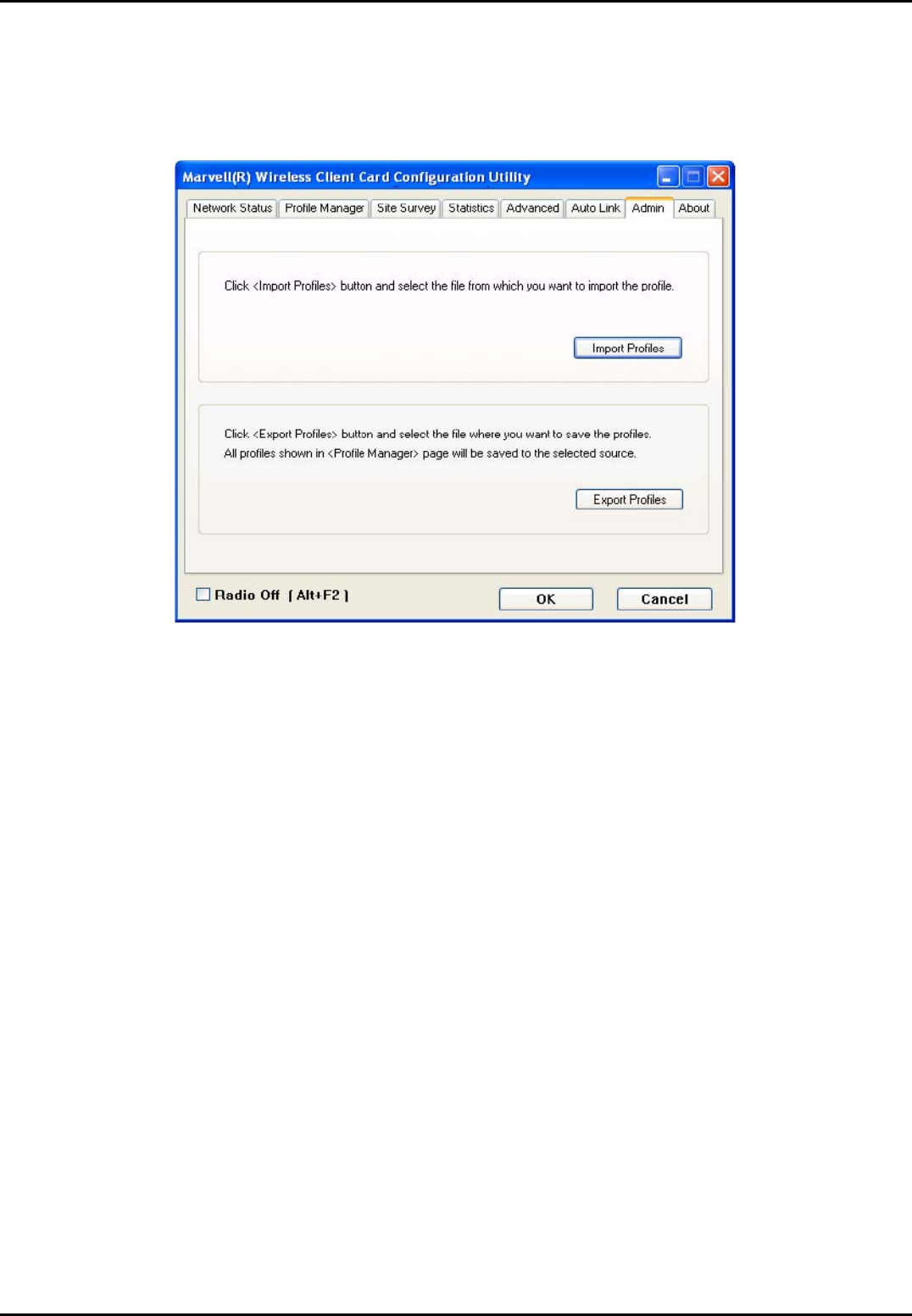
Appendix B Error Messages of Enabler Program
3.7 Admin Tab
The Admin tab allows you to import and export profiles.
Figure 40: Admin Tab
3.7.1 Admin Tab—Import Profiles
To import a profile, proceed as follows:
1. 1. Click Import Profiles.
2. 2. Select the path and filename of the profile.
3. 3. Click Open.
3.7.2 Admin Tab—Export Profiles
To export a profile, proceed as follows:
1. 1. Click Export Profiles.
2. 2. Select or enter the path and filename of the profile.
3. 3. Click Save.
3.8 About Tab
The About tab displays information about the WM821-M Client Card Configuration Utility.
27
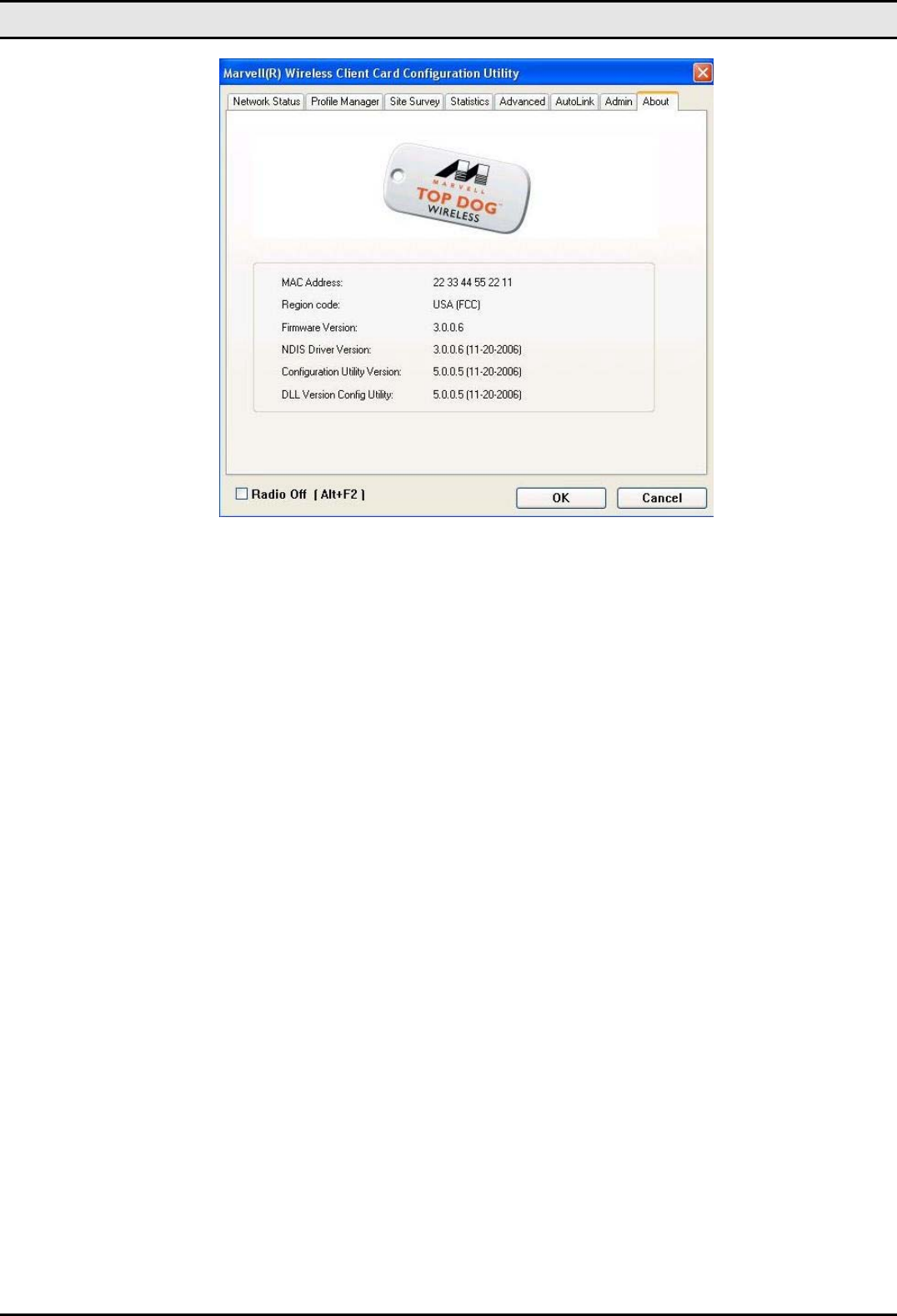
WM821-M MiniPCI Module —Using the Wireless Utility
Figure 41: About Tab
28

Appendix A
Specifications
Specifications
Product Name Draft 802.11n-compatible Dual Band WLAN mPCI Card
Interface mPCI 32 Type III-A
Network Standards IEEE802.11a/g/b Draft n-compliant
Data Rate
54, 48, 36, 24, 18, 12, 9, 6, 11, 5.5, 2,1Mbps
20MHz BW: 130, 117, 104, 78, 52, 39, 26 and 13Mbps
40MHz BW: 300, 270, 243, 216, 162, 108, 81, 54 and 27Mbps
Modulation 802.11a/g/n---- 54, 48, 36,24,18,12,9,6Mbps (OFDM)
802.11b ---- CCK (11Mbps, 5.5Mbps), QPSK (2Mbps), BPSK (1Mbps)
Operating Frequency 2.412 ~ 2.462 GHz: North America
2.412 ~ 2.472 GHz: Europe ETSI
2.412 ~ 2.472 GHz: Japan (ARIB STD-T66)
5.15 ~ 5.35GHz/ 5.47~5.6/ 5.65~5.825 GHz: North America UNII
5.15 ~ 5.35GHz/ 5.47 ~ 5.725GHz: Europe ETSI
4.9 ~ 5.0GHz/ 5.15 ~ 5.35GHz: Japan
Operating Channels
11b: 1~11 for America,1~13 for Europe (ETSI),1~14 for Japan
11g: 1~11 for America,1~13 for Europe (ETSI) and Japan (ARIB STD-66)
11a: 36-64, 100-161 North America; 36-64 for Japan and other ch definitions
RF Output Power
15 dBm (2.4GHz, 11Mbps, CCK, typical for CH 1,11)
17 dBm (2.4GHz, 11Mbps, CCK, typical except CH 1,11)
13dBm (2.4GHz) (54Mbps, OFDM, typical for CH 1,11)
15dBm (2.4GHz) (54Mbps, OFDM, typical except CH 1,11)
13dBm (2.4 or 5GHz, 40MHz BW, all channels)
12 dBm (5GHz, 54Mbps, OFDM typical)
Antenna Three IPEX connectors with diversity for external antenna
LED Indicators Power LED: GPIO control
Link LED: GPIO control
Coverage Area
Indoor: 20M@54Mbps, 35M@24Mbps, 60M@6Mbps, 100M@11Mbps
Outdoor: 50M@54Mbps, 65M@48Mbps, 90M@36Mbps, 120M@24,18, 12,9,6Mbps,
80M@11Mbps, 120M@5.5Mbps, 200M@2Mbps, 300M@1Mbps
Receiver Sensitivity
-86 dBm @ 11M (CCK, 8% PER)
-70 dBm @ 54M (11g,OFDM, 10% PER)
-65 dBm @ 54M (11n,OFDM, 10% PER)
Power Consumption TX power consumption @3.3V: 600-850mA
RX power consumption @3.3V: 500-700mA
Support OS Linux, Microsoft Windows Windows 2K, Windows XP (TBD)
29

WM821-M MiniPCI Module —Using the Wireless Utility
Operating Temperature 0 to 55 ℃
Humidity 20% to 95% Non-condensing
Dimensions (mm) (W) 59.6mm × (D) 50.95mm × (H) 4.9mm
Weight (g) 28 g
Voltage 3.3V
30
